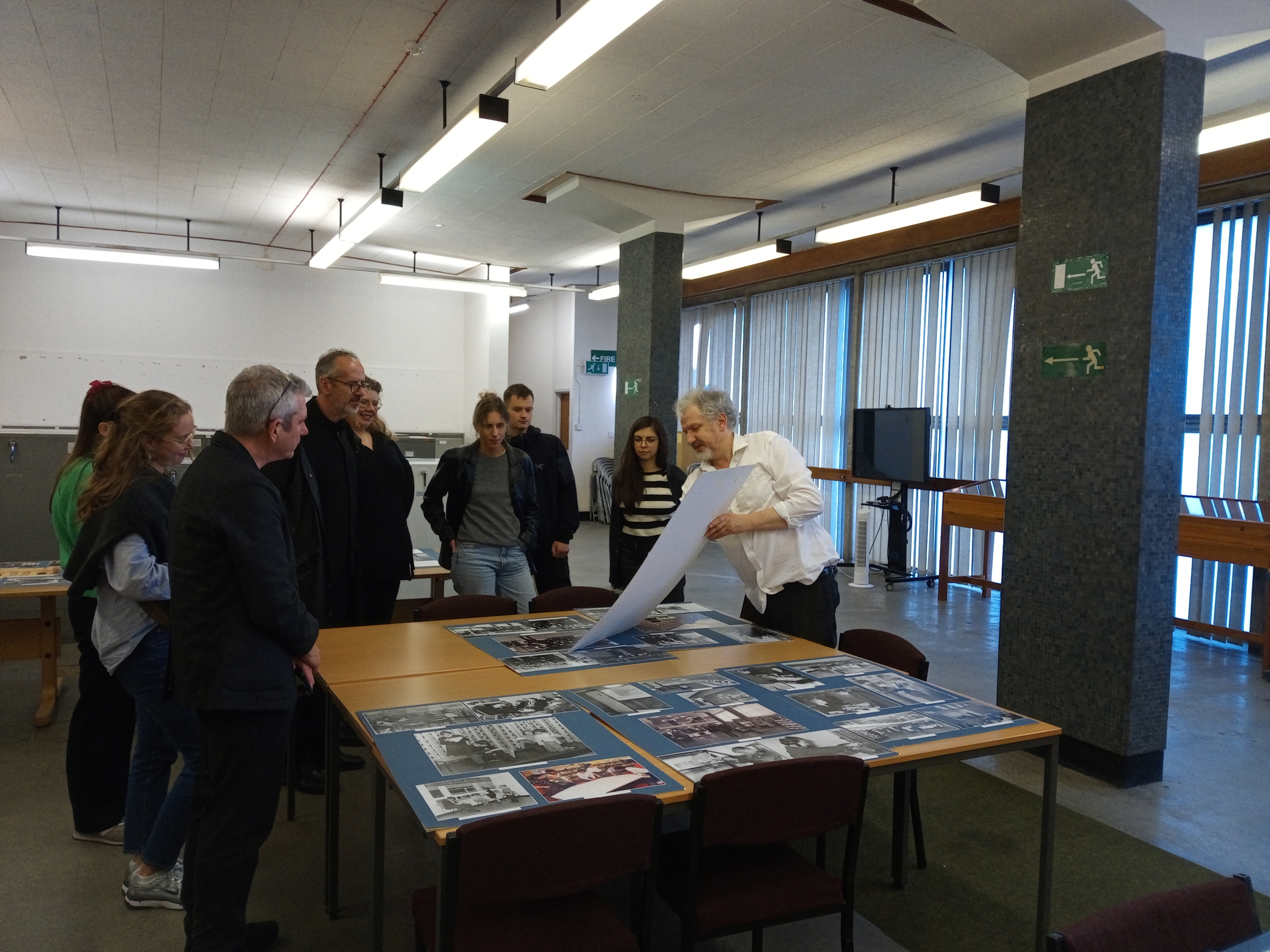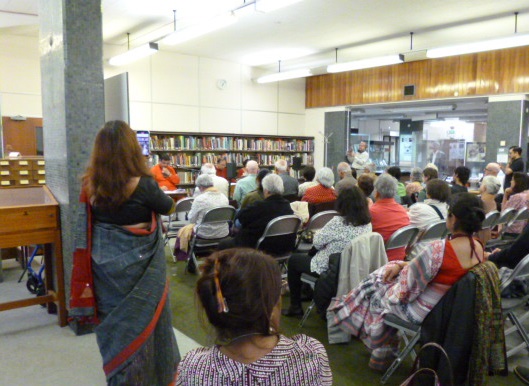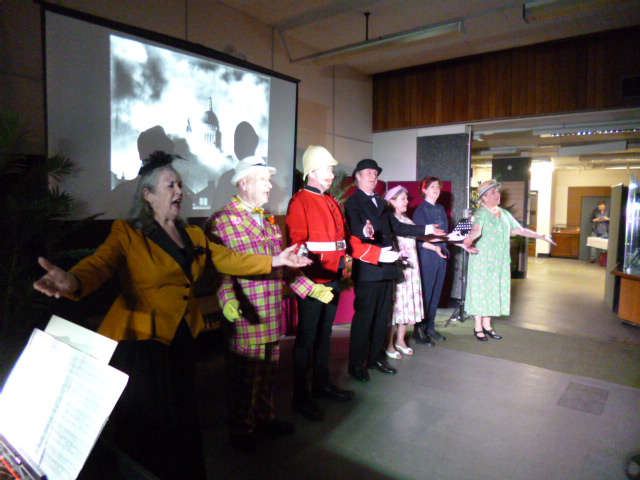The Small Pox Hospital - A New Acquisition
The collections of Camden Local Studies and Archives Centre are continually growing as we take in new historical material which becomes available. The vast majority of these accessions are donations but occasionally we purchase items. Two special documents recently came up for sale which we thought important to acquire. These are an 1836 report of the Small Pox and Vaccination Hospital at Battle Bridge and a report of Dr Gregory, the Hospital’s Physician, dating from the same year. The total price for the two items was £975. Our budget for purchasing archives is limited but with the Friends of the Nations’ Libraries generously agreeing to pay half the cost, we were able to acquire them both.
Title page of one of the two reports newly acquired © CLSAC
In the 18th century smallpox was probably the most lethal disease in Britain and it was in 1756 that the London Smallpox Hospital was founded in Windmill Street, off Tottenham Court Road, reputedly the first institution of its kind in Europe. In 1794 the hospital moved into new purpose-built premises at Battle Bridge, the area today known as King’s Cross.
The Small Pox Hospital c.1835 © CLSAC
From 1791 to 1805 the hospital’s physician was William Woodville, one-time assistant to the vaccination pioneer, Edward Jenner. In 1799 – three years after Jenner had first tested his smallpox vaccine - Woodville introduced vaccination against the disease at the hospital. Around 1850 the hospital was demolished to make way for King’s Cross Station and replaced by a new hospital at Highgate which operated until 1896.
Portrait of William Woodville © CLSAC
We have little archival documentation relating to this historically important institution and these two reports are a precious addition to our collections. They are a mine of information about the hospital including its early history, its rules, its accounts, statistics and names and addresses of governors. We learn that over the past year: 401 people had been treated there of whom 312 had recovered, that 4140 persons had been vaccinated there, a then record for the hospital, and that 1767 doctors and others had been supplied by the hospital with vaccine lymph. In the general report we read that “No stronger proof can be given of the efficacy of good Vaccination, and of the confidence of the inhabitants of London in that protection against the Small-Pox which this Hospital offers than this - that, for the last twenty-seven years, the numbers vaccinated at this Institution have been continually, and even rapidly, augmenting”.
And in his report, Dr Gregory states that “Vaccination is still entitled to the highest praise as a means of diminishing both the quantity and the severity of Small Pox”. More bleakly, he claims that “the hopes once entertained of banishing the Small Pox from the earth, are utterly visionary and groundless”. Happily, in this he has been proved wrong. Smallpox was eventually eradicated. But not until 1977, after many millions more people on the planet had perished from the deadly disease.
Welcoming an Archivist from Tokyo to Camden Archives
Camden Local Studies and Archives Centre, naturally, has a special importance for the local community. But we are open to all. And our collections bring in visitors from across the globe. You might find a resident from down the road researching here. Equally, you could find using the Centre an academic from the States or a genealogist from Australia.
Recently we were pleased to welcome to our archive, a visitor from Japan, Nami Won. Nami is an assistant professor and archivist at the University of Tokyo Archives. She was in London visiting archives here as part of her international comparative research in to the setting up and managing of local archive services.
Nami with Archivist, Tudor Allen and the Eleanor Farjeon book in Japanese
I wondered whether we had anything Japanese-related in our collections to show Nami and a colleague reminded me of our Farjeon collection. Eleanor Farjeon, though best known for the lyric of the hymn Morning Has Broken, was an award-winning writer of children’s poetry and fiction. She lived from 1920 to her death in 1965 at 20 Perrin’s Walk in Hampstead and in 1960 gifted a collection of books by and about her to Hampstead Libraries. These are now with us and include editions of her works in a number of languages including the Japanese version of her story Martin Pippin in the Apple Orchard.
The University of Tokyo’s iconic Yasuda Auditorium © Nami Won
The University of Tokyo, where Nami is based, holds some wonderful archives of its own. As an example, Nami sent me a photograph of an 1878 document entitled The Case of Mr. Strange, a British National, and His Travel for Academic Research. During the Meiji period in Japan (1868-1912), the Japanese government hired many foreign employees to bring their knowledge and skills to the modernisation of the country. Among these were educational advisors based at the University of Tokyo and its predecessor schools. Frederick William Strange was one of them. As well as working as a university educator, Strange, himself a rower and sportsman, is credited with introducing competitive rowing into Japan and popularising athletics and outdoor team sports there. He also has a local connection as he was educated in Bloomsbury in the 1860s at University College School, Gower Street.
The Case of Mr. Strange, a British National, and His Travel for Academic Research ©The University of Tokyo Archives, Japan
For Nami, the journey has been in the opposite direction to Mr Strange - from Japan to Britain. We hope her own travel for academic research has been fruitful and enjoyable.
St Pancras Signals on Loan at Bow
Among the wonderful holdings we have at Camden Local Studies and Archives Centre are many art works, depictions of local scenes and people, invaluable as a historical record, and often fine works of art in themselves. One of the oil paintings in our collections is currently on display in an exhibition in East London. Last year we were approached by the Bow Arts Trust asking if we would loan them the picture for inclusion in an exhibition they were mounting on the East London Group, an association of mainly working-class artists who worked and exhibited together in the late 20s and 30s, typically painting East London scenes. The painting we have loaned to the exhibition is St Pancras Signals by Elwin Hawthorne.
St Pancras Signals © CLSAC
Hawthorne was a casual labourer and errand boy who worked from 1928 to 1931 as a studio assistant for the celebrated English painter, Walter Sickert. Sickert, who tutored members of the East London Group at one time, recognised the ability of Hawthorne who went on to produce many London street scenes as well as landscapes and seascapes. St Pancras Signals depicts Goods Way in the Kings Cross area in 1930 with, in the background, railway signals on a track leading to St Pancras Station. It was donated to Camden Libraries in 1965 by Norman E Binns, Borough Librarian of Ealing. The exhibition it currently appears in is entitled In the Footsteps of the East London Group. It is showing at the Nunnery Gallery at 181 Bow Road until the 22nd of December.
Find out more about the exhibition on the Bow Arts website.
View of the exhibition with St Pancras Signals to the right of the door © Rob Harris
Camden Local Studies and Archives Centre holds an estimated 631 engravings, 482 drawings, 1354 watercolours, 1117 prints, 469 etchings, 435 lithographs, 127 woodcuts and 241 oils. Many of our oil paintings can be viewed on the Art UK website
An Archive of Camden and... New Zealand
Camden Local Studies and Archives Centre have recently taken in a wonderful new collection relating to the post-war years in Camden, sent to us all the way from Paraparaumu Beach in New Zealand. They comprise around 35 letters sent from children at two schools in Kentish Town to a Mrs Edna Campbell of Woodlands, South Island, New Zealand. Dating from the early 50s, the letters, written by pupils of Torriano and Rhyl primary schools, express thanks for an unusual but then much valued gift – fat!
Page from one of the letters © CLSAC
Rationing in Britain continued well after World War Two and in the early 50s meat, sugar and eggs continued to be rationed as did butter, margarine and cooking fat. When a national Food for Britain campaign in New Zealand was ended by the government in 1947, Philip Barling, a businessman from Dunedin on South Island, feeling that Britain still needed help, began his own Fat for Britain campaign, which he personally funded and organized. Farmers’ wives from the South Island provinces of Otago, Southland and Canterbury were provided with tins to fill with fat for dispatch to Britain and rationing out to British families. Edna Campbell was one of these women. Recipients were encouraged to write letters of thanks and fortunately Edna kept all those she received.
The letters from the Kentish Town children, often illustrated with their own drawings, are charming and informative. They tell us about life at the time as seen through children’s eyes. The pupils write about their school life, their home life, their hobbies and their pets, and they speculate about what life was like for those in New Zealand. Conversely, Edna’s daughters, apparently much enjoyed reading the letters and finding out about life for London children - so different from their own, growing up on a sheep farm on the other side of the world.
Edna Campbell with her daughters in 1951 © Gordon Campbell
A big thank you to Edna’s nephew, Gordon Campbell, for kindly donating to us this marvellous record of a special piece of local, national - and international -history.
Collecting and Celebrating Camden's Black History
For some time now Camden Local Studies and Archives Centre has been working with Emily Momoh, founder of the Camden Black British History Community Hub to increase the documentation of the borough’s Black history. A nice example of an archive collected by Emily and transferred to us is this lovely wedding day photograph taken outside St Luke’s Church in Kentish Town in 1959.
© CLSAC
It shows Dorien Hayes and his wife Sheila. both originally from Barbados. Sheila came to Britain in October 1958 on the SS Montserrat, disembarking at Southampton where she met Dorien who had arrived in the country the previous year. Their first place of residence was Marquis Road in Camden - “the only Black people living in that street”, Sheila recalls. Dorien worked for the railways for approaching 40 years while Sheila’s first job in London was working in the Marking Office at Harrods. A big thank you to Sheila for kindly donating this photograph.
If you have any archives of Camden’s Black community or would like to volunteer at Camden Local Studies and Archives Centre to produce an index to Black history stories in our local newspaper collection, Emily would love to hear from you at: [email protected]
You may remember that a couple of years back our Centre hosted a wonderful exhibition curated by Emily - We Were Here, focusing on eight significant individuals of African and Caribbean heritage who lived, worked or studied in Camden. View a digital version of this display (scroll to the third item down).
Two of the figures featured in this exhibition have been in the news lately. Billy Waters, the famous London busker, is the subject of a new book by Mary Shannon, Billy Waters is Dancing which was launched at Daunt Books, Marylebone High Street on the 11th of June.
And, on the 15th of June, a plaque was unveiled in Whitfield Gardens, a memorial to the writer and abolitionist, Olaudah Equiano, who was buried nearby in 1797. After discovering from records at the London Metropolitan Archives, that Equiano had been buried at the former Whitefield’s chapel on Tottenham Court Road, Arthur Torrington, the founder of the Equiano Society, worked over a number of years - with the American International Church (today on the site of the chapel) and with the London Borough of Camden - to have a plaque commemorating Equiano’s burial place installed. The plaque was mainly funded by the Greater London Authority’s Untold Stories programme. The unveiling ceremony, attended by the Mayor of Camden – Councillor Samata Khatoon - included readings by actor, Burt Caesar, from Equiano’s autobiography The Interesting Narrative of the Life of Olaudah Equiano.
Emily Momoh, Councillor Samata Khatoon and Arthur Torrington with the plaque © Emily Momoh
Later in the year we hope to have a talk in the Centre on a third individual featured in the We Were Here exhibition – the abolitionist, Robert Wedderburn.
Ms Heal and the Heal Collection
Christianne Heal on her visit with an illustration of Heal’s store from the collection © CLSAC
We were delighted to receive a special visitor to the Centre recently – Christianne Heal of the family who founded and ran for almost two centuries the famous Heal’s furniture store in Tottenham Court Road, one of Camden’s most famous shops.
Christianne is the granddaughter of Sir Ambrose Heal, the celebrated furniture designer who was the chairman of the store from 1913 to 1953. But the reason for her visit was in connection to her great-grandfather, also called Ambrose Heal.
As well as chairing the company – from 1907 to 1913 – this Ambrose Heal was a great collector. Over the years he acquired a treasure trove of archives relating to the old parish of St Pancras and in his will he bequeathed this collection of books, prints, pictures and “articles of curiosity and vertu” to the borough council.
Today this priceless historical resource is held here at Camden Local Studies and Archives Centre and Christianne came along to view it. It was the first time in her life she had seen it and she clearly thoroughly enjoyed the day she spent here. Though what she could see in that time was only a fraction of this superb collection.
Christianne, who was a Camden resident – in Hampstead - for over 50 years, has had a very different career to her great-grandfather, working as a counsellor and psychotherapist. But she shares his love of collecting and has compiled sixteen scrapbooks of her own on art-related themes. It must be in the blood!
All items in the Heal collection are described on our online catalogue here and can be viewed in the Centre during our opening hours. (Monday 10-6, Tuesday 10-6, Thursday 10-7, Alternate Saturdays 11-5).
Christianne studying one of the many folders in the Heal collection © CLSAC
A Snapshot of Bloomsbury in 1958
3 – 5 Bernard Street © CLSAC
A new donation to Camden Local Studies and Archives Centre is a real treasure trove of information on a part of Bloomsbury as it was in the late 1950s. A sale catalogue for the Foundling Estate, it provides a fascinating snapshot of the locality in 1958.
The Foundling Hospital was an orphanage for abandoned and destitute children, established in 1739, and sited where Coram’s Fields playground is today, from 1745 up until its demolition in 1926. The institution owned some 56 acres of land in the area.
In 1930 most of this land was acquired by the Dominion Student’s Hall Trust, founded that year to set up a hall of residence for international postgraduate students. Based in Mecklenburgh Square, this hall evolved in to today’s Goodenough College.
In 1958 the Trust sold the freehold in the estate at an auction held at the Royal Hotel, Woburn Place on the 26th and 27th of November. It was for this auction that the sale catalogue was produced.
© CLSAC
The document provides details of shops, offices, hotels, flats and hostels in a dozen streets and squares including Marchmont Street, Bernard Street, Brunswick Square, Mecklenburgh Square and Tavistock Place. There are detailed descriptions of the buildings with rateable values and lists of tenants. There are also some photographs and building plans.
© CLSAC
The sale catalogue was kindly donated to us by Roy Moffat who inherited it from his grandmother, Violet. She ran the Hotel Cecil in Bernard Street from the 1930s up until her death in 1960.
Talk at the Tin Tabernacle
© Francesca Murialdo/Kilburn Museum Lab
Kilburn Library and Camden Local Studies and Archives Centre are partnering Francesca Murialdo of Middlesex University and Ada Hao of the Paprika Collective on the “Kilburn Lab Museum”. This British Academy-supported project aims to engage the local community through a variety of activities focussing on the cultural and historical heritage of Kilburn.
As part of this, Francesca invited Tudor Allen of the archives centre to give a talk on the history of this fascinating area. The venue was, appropriately, one of Kilburn’s historic buildings – the “Tin Tabernacle”, an iron church in Cambridge Avenue dating from 1863. In the 19th century, temporary iron churches were often built prior to the construction of brick ones. But in this case funds were not forthcoming for replacement by a permanent building and so Kilburn possesses one of the few iron churches to have survived in the country.
After the Second World War, the Willesden sea cadets acquired the building and converted its interior in to a replica of a minesweeper ship. The Tin Tabernacle made a great location for a talk on the history of the locality. Approaching one hundred people attended the event.
Tracking the Heritage with Camden Highline
Copyright of Paul Romans Photography (www.paulromans.com)
Camden Local Studies and Archive Centre have recently been partnering on an exciting heritage project, funded by the National Lottery Heritage Fund. “Tracking the Heritage” is a project led by Camden Highline, the charity working on the creation of a new public space within the borough - an elevated park and greenway which will run alongside the disused section of the old North London railway line between Kings Cross and Camden Town. “Tracking the Heritage” aims to give local young people the opportunity to explore the heritage of the area around the proposed highline and to introduce them to archival research. As part of it, on 2nd February, a workshop was held in our archives centre for nine young people in which they worked with resources we hold relating to Agar Town - the short-lived poor neighbourhood to be found north of St Pancras Station in the mid-19th century - and to materials we have relating to the history of live music in Camden. The workshop was run by Rob Bevan, heritage specialist, Venetia Wolfenden, education specialist, Roisin Morrison and Alex Ross of Camden Highline and Tudor Allen, Archivist at the Centre. Camden Highline is due to open in 2026.
Copyright of Paul Romans Photography (www.paulromans.com)
Copyright of Paul Romans Photography (www.paulromans.com)
Copyright of Paul Romans Photography (www.paulromans.com)
To stay up to date with the “Tracking the Heritage” project, including details about an upcoming exhibition, you can join the newsletter list at here
Archives of Remembrance
Sometimes archives have a meaning beyond mere historical value. Among the documents we hold at Camden Local Studies and Archives is a very sad one dating from 1918. Addressed to a Kentish Town woman, it’s an official document issued by the Army's record office, notifying her of the death of her husband from wounds received in action on the 3rd of November, just days before the Armistice.
Equally poignant are records of remembrance. An example from our own collections is the Holborn Book of Remembrance commemorating those Council staff and councillors who died serving in the Forces during the two World Wars. This is the first page of the volume.
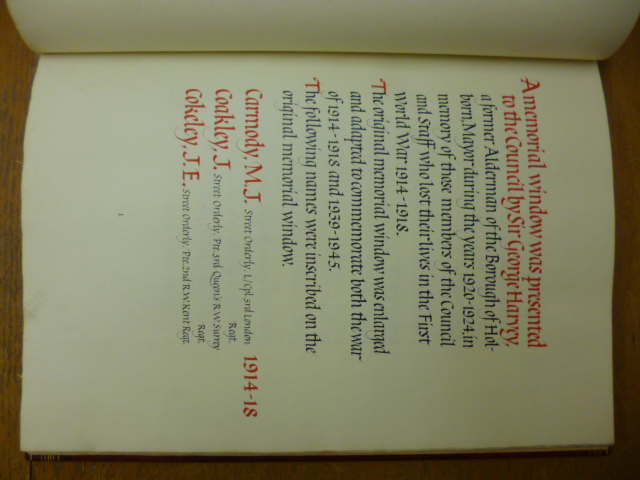
I am pleased to say we recently purchased at auction another record of remembrance – the roll of service of Netherwood Street School, Hampstead which lists staff and former pupils who lost their lives on the Front in the Great War. With it came the cabinet in which it had been displayed at the school.
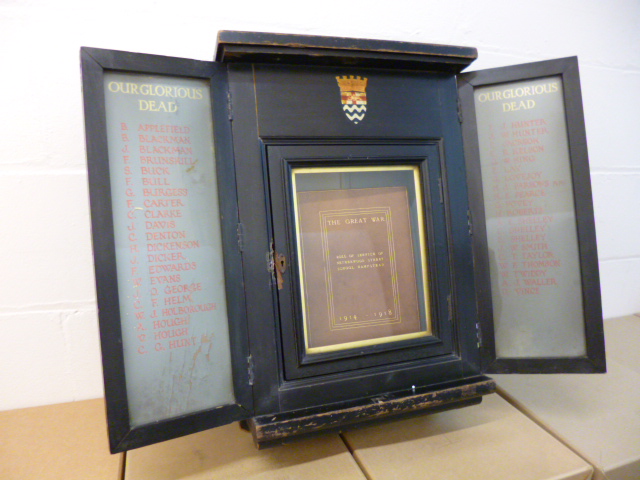
Equally poignant are the body of photographs we hold of two military units raised in Hampstead during World War One – the Hampstead Howitzers (the 183rd brigade of the Royal Field Artillery) and the Hampstead Heavies (the 138th battalion of the Royal Garrison Artillery). The collection includes this haunting image of Howitzers encamped on Golders Hill Park late in 1915.
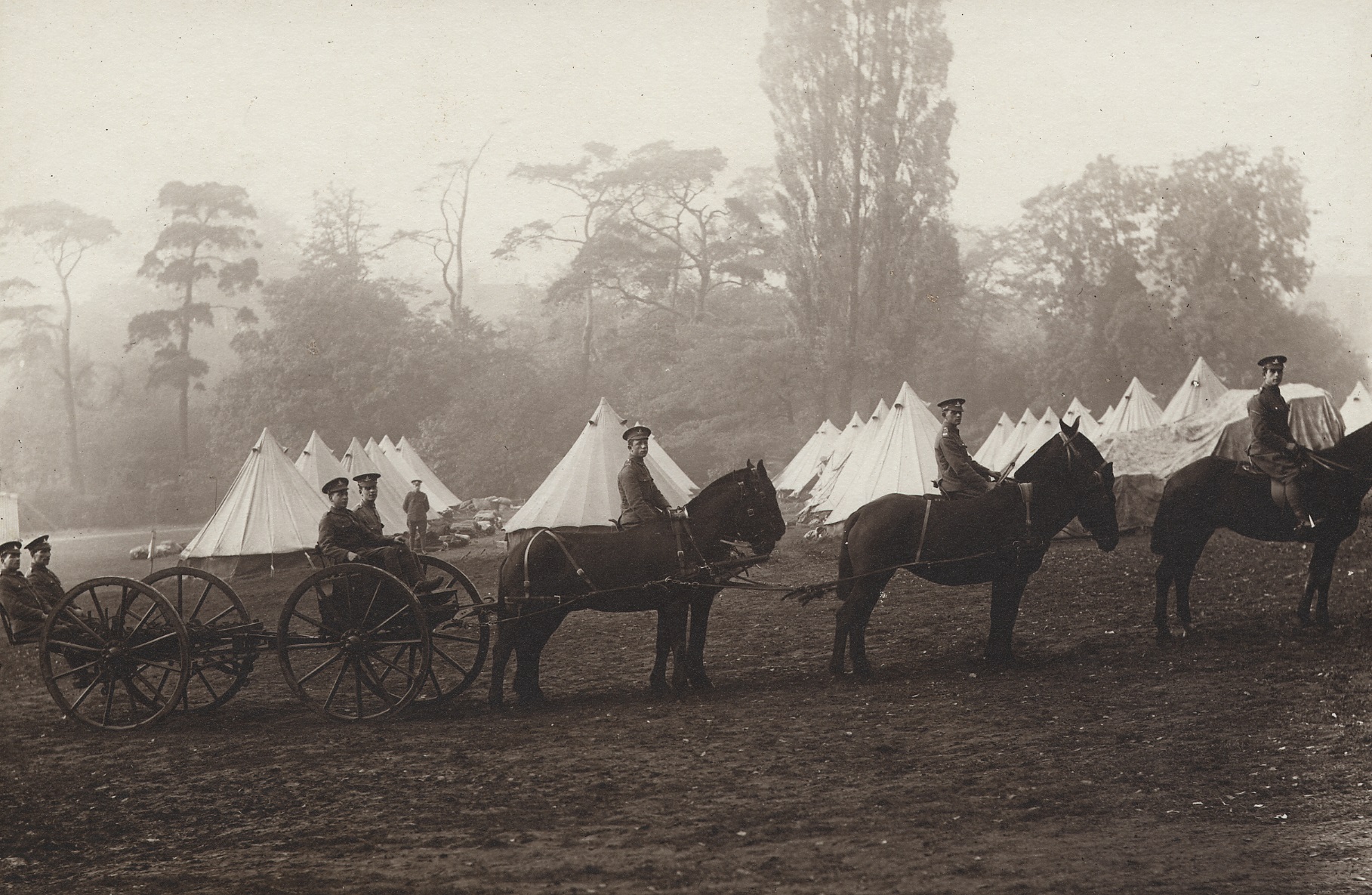
© Camden Local Studies and Archives Centre
An Exciting New Accession
The collections of Camden Local Studies and Archives Centre are continually growing as we take in new historical material which becomes available. The vast majority of these accessions are donations but occasionally we purchase items. A special document recently came up for auction which we thought it was important to try to acquire. This was a rare map of St Pancras which we did not already have - a hand-coloured Edmund Daw map of the parish dating from 1854. We had maps of the area by this cartographer for 1849 and 1860 but not this 1854 edition.
We expected the map to be well out of our price range so we put a bid in to the FNL (Friends of the National Libraries). I am pleased to say the bid was successful and they kindly agreed to provide 90 per cent of the expense. The total cost was £1087 but thanks to the FNL’s generosity it cost the archives centre only £144.
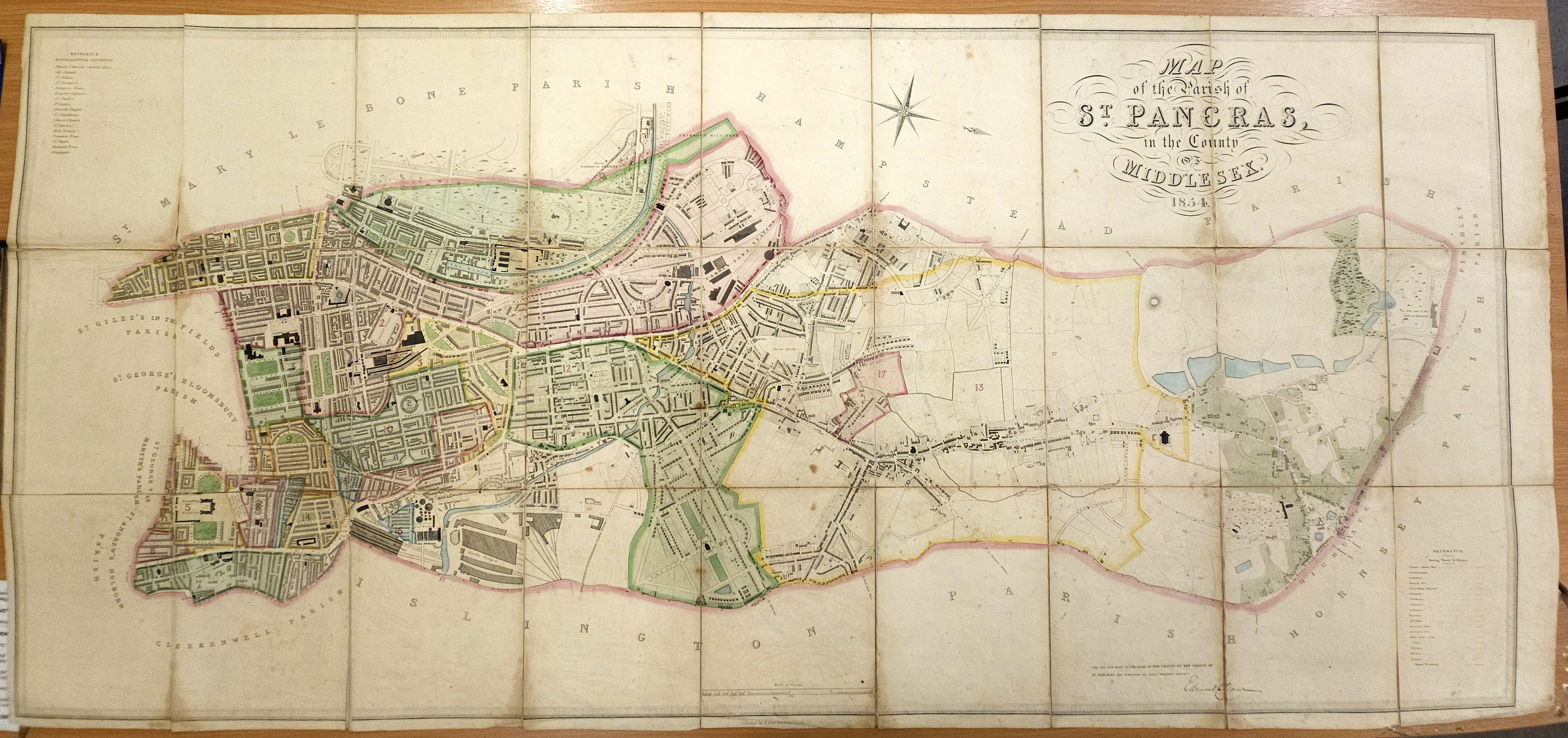
© Camden Local Studies and Archives Centre
Some major changes are quickly apparent from a comparison of the 1849 and 1854 maps. By the time of the later map the Smallpox and Fever hospitals shown at King’s Cross in 1849 have gone. While King’s Cross Station and its goods yard and hotel, absent from the earlier map, are all clearly shown on the 1854 one. But there will be other less obvious differences and the new map will be invaluable for researchers trying to pinpoint dates of changes within the parish.
Though the map is in good condition it would be damaged by regular handling. We will therefore be scanning it and printing a facsimile for use by researchers.
You can learn about some of the great work the FNL do to support libraries here
A Special Connection to a Special Building
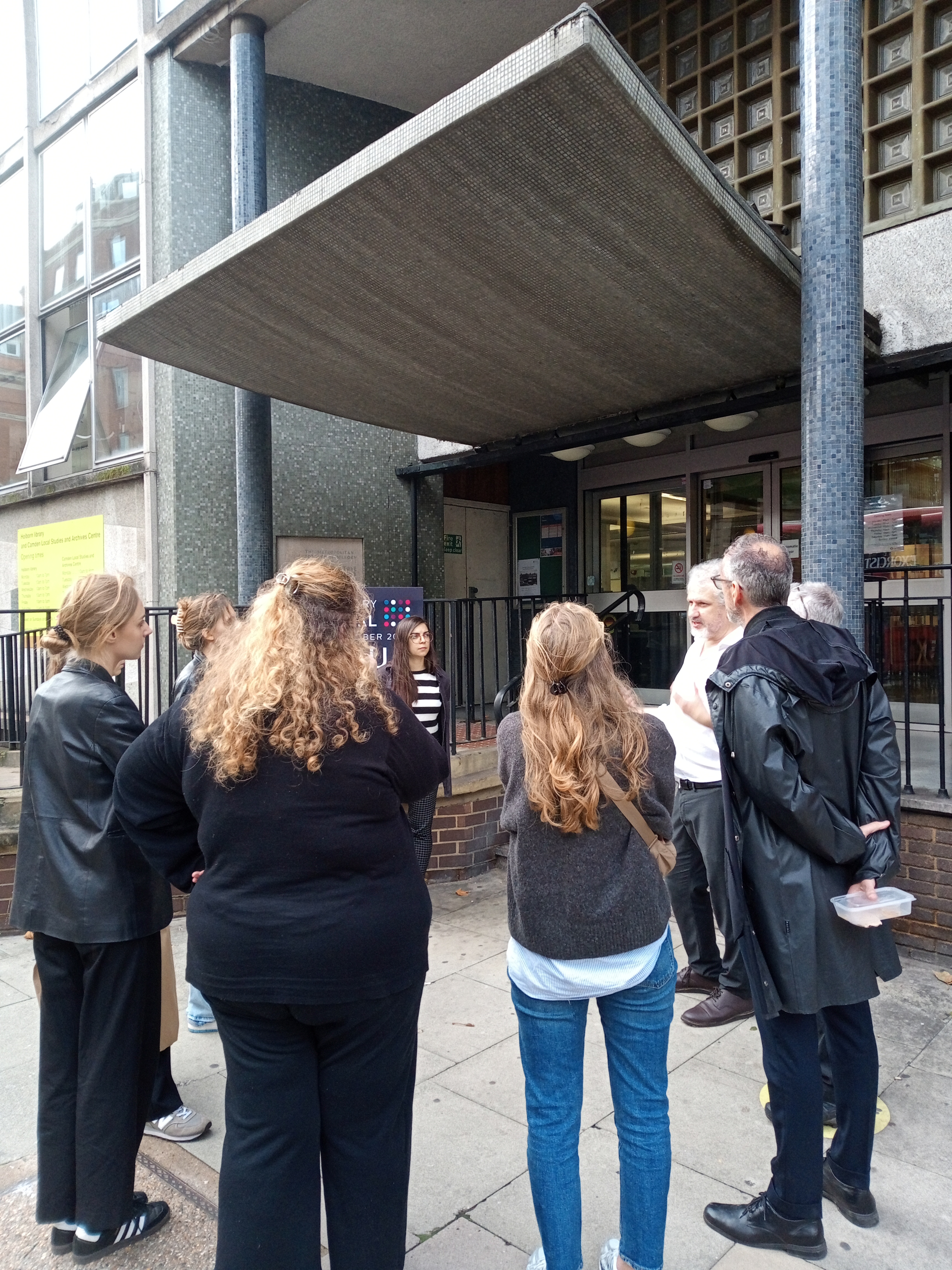
Holborn Library, home to Camden Local Studies and Archives Centre, itself has an important place in history. When it first opened its doors to the public back in 1960 it was lauded as the most modern and state-of-the-art library in the country. Taking influence from Scandinavian libraries with its mezzanine, balcony, glass frontage and other features, it, in turn, influenced later UK library buildings including, in London, those of Finsbury and Hornsey. This pioneering building has been described by English Heritage as “a milestone in the history of the modern public library”.
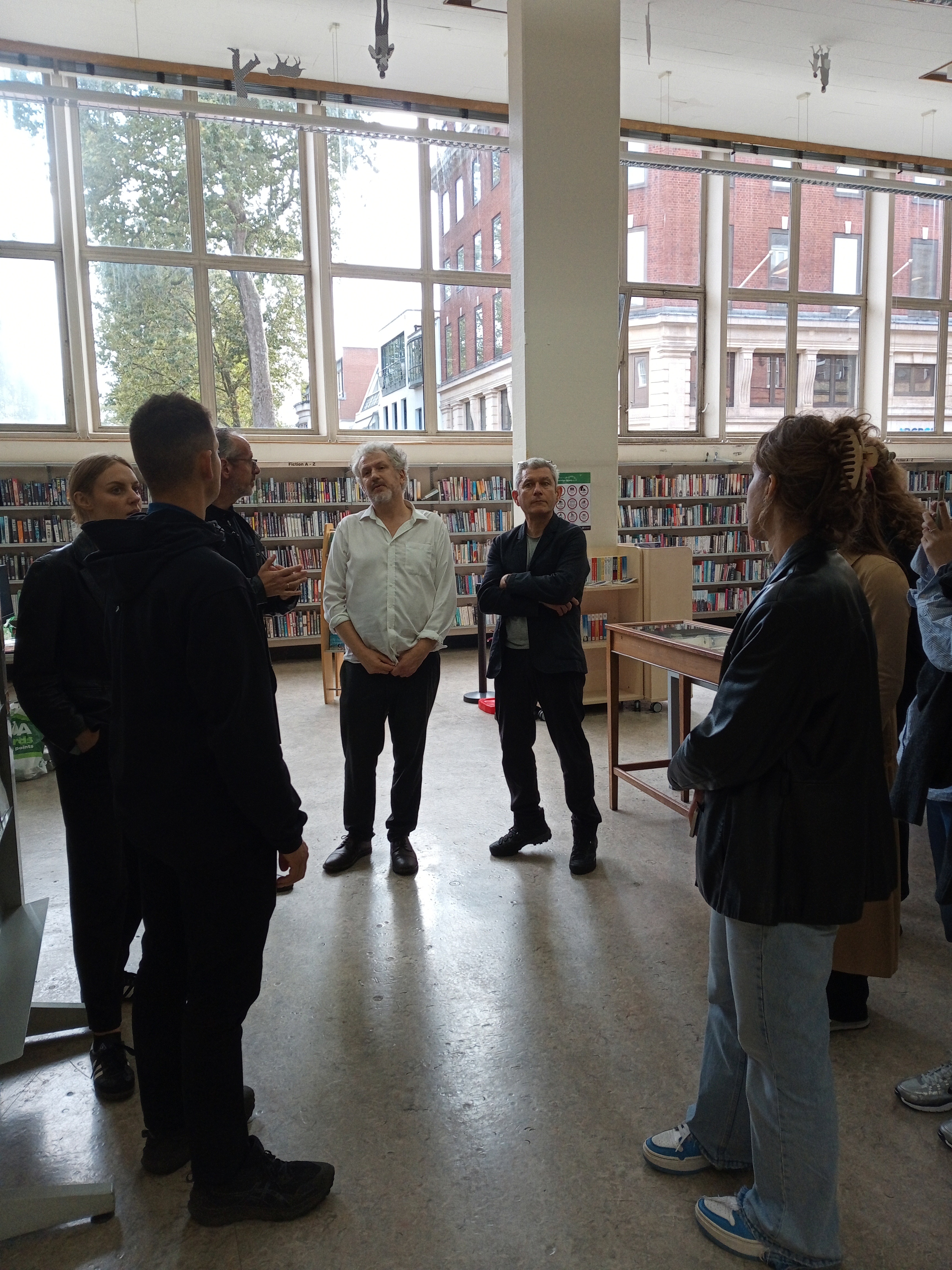
Its designer was Sydney Cook, then Holborn’s Borough Architect. Later, as Camden’s Borough Architect from 1965 to 1973, he was to lead an acclaimed housing programme which included the Alexandra Road, Branch Hill and Highgate New Town estates.
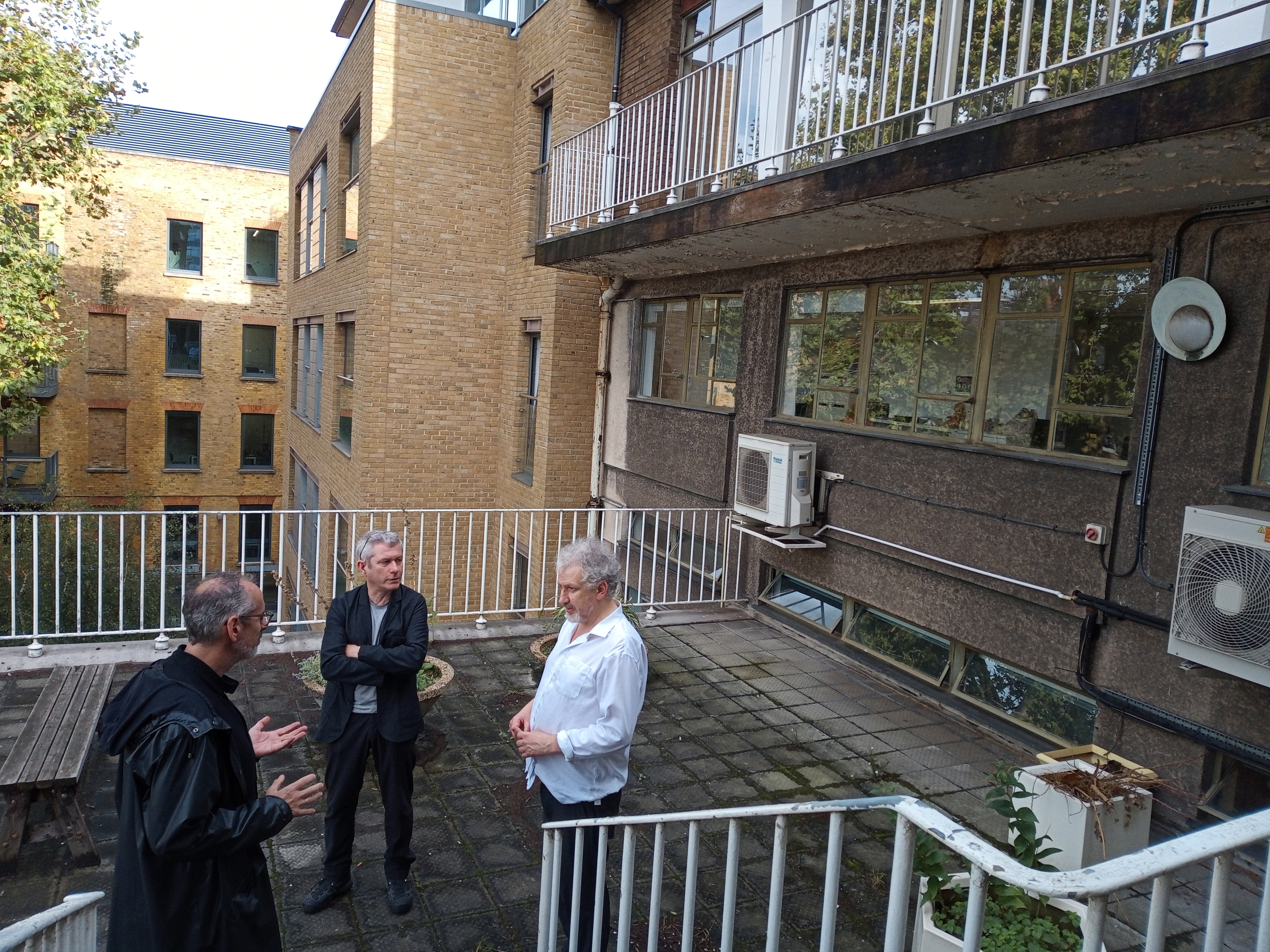
Rupert Cook is pictured here (centre)
Here at the archives centre we were delighted some weeks back to be contacted by Cook’s grandson, Rupert, himself an architect. His firm - Miltiadou Cook Mitzman Architects- have recently moved to premises only minutes away from his grandfather’s library and Rupert was enquiring whether its staff might have a tour.
We were happy, of course, to oblige and it was a delight to show Rupert and his colleagues around and to see their enthusiasm for this special building.
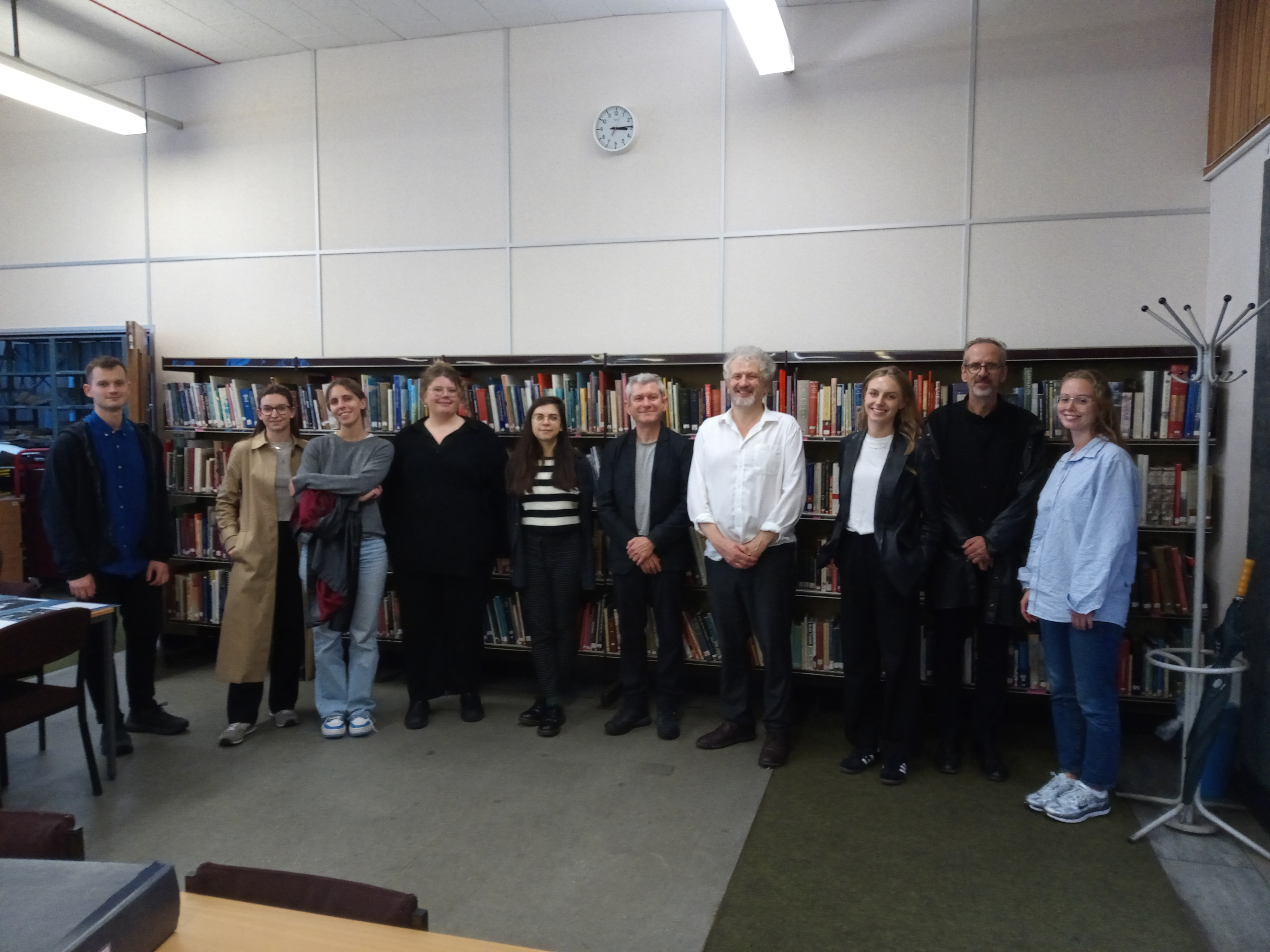
From Train Tracks to Record Tracks
Documenting Camden’s Working Life
Over the years Camden Local Studies and Archives Centre have worked with many partners on a range of projects relating to aspects of Camden’s history. Of these the one we have worked most often with is Digital Works. An arts and educational charity, Digital Works run oral history projects across London working with communities to explore the history of work and workers in the capital. Subjects they have dealt with over the years include: the printers of Fleet Street, bus workers, underground workers, black cab drivers, the tailors of Saville Row and Thames lightermen.
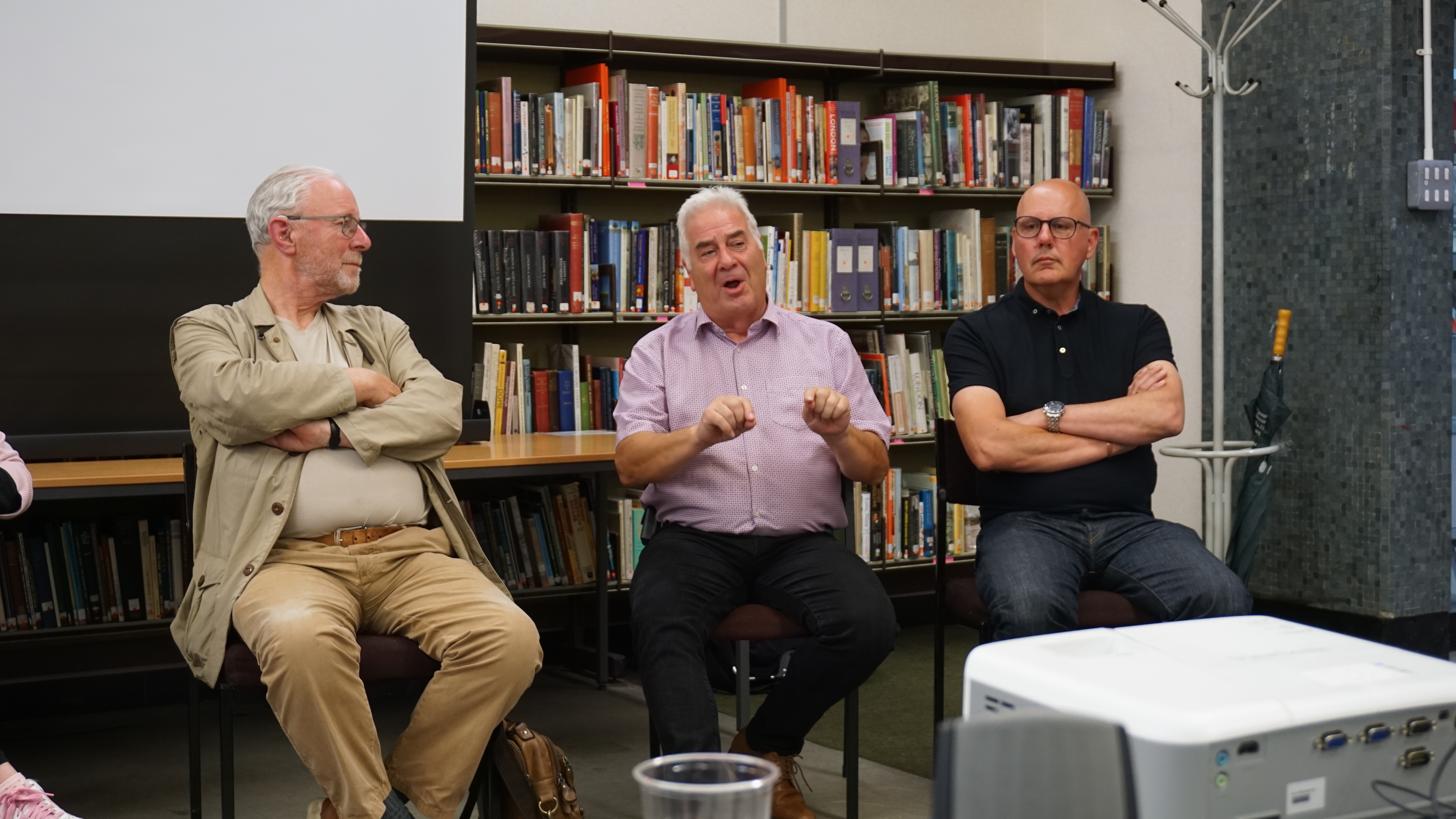
Former drivers, Ray Knight, Steve Forey and Chris Luesley after the film screening © Sav Kyriacou
In past years we have supported two of their Heritage Lottery Fund projects - one working with schools to explore the history of Leather Lane Market, and another looking at the story of the jewellery makers of Hatton Garden. And this year we have been working with them on two more.
The first – “Tracking the Heritage” - collected the memories of former King’s Cross station staff and culminated with Digital Works putting together a wonderful film exploring the history of the great station as seen through the eyes of its workers. “The Train at Platform 5” draws on interviews with drivers, guards, and other station staff to chart the many changes in the work and the station from the days of steam up to the present day.
On the 4th of July the film was screened in our Centre, followed by a fascinating question and answer session with some of the participants, including three former train drivers. You can watch the film here
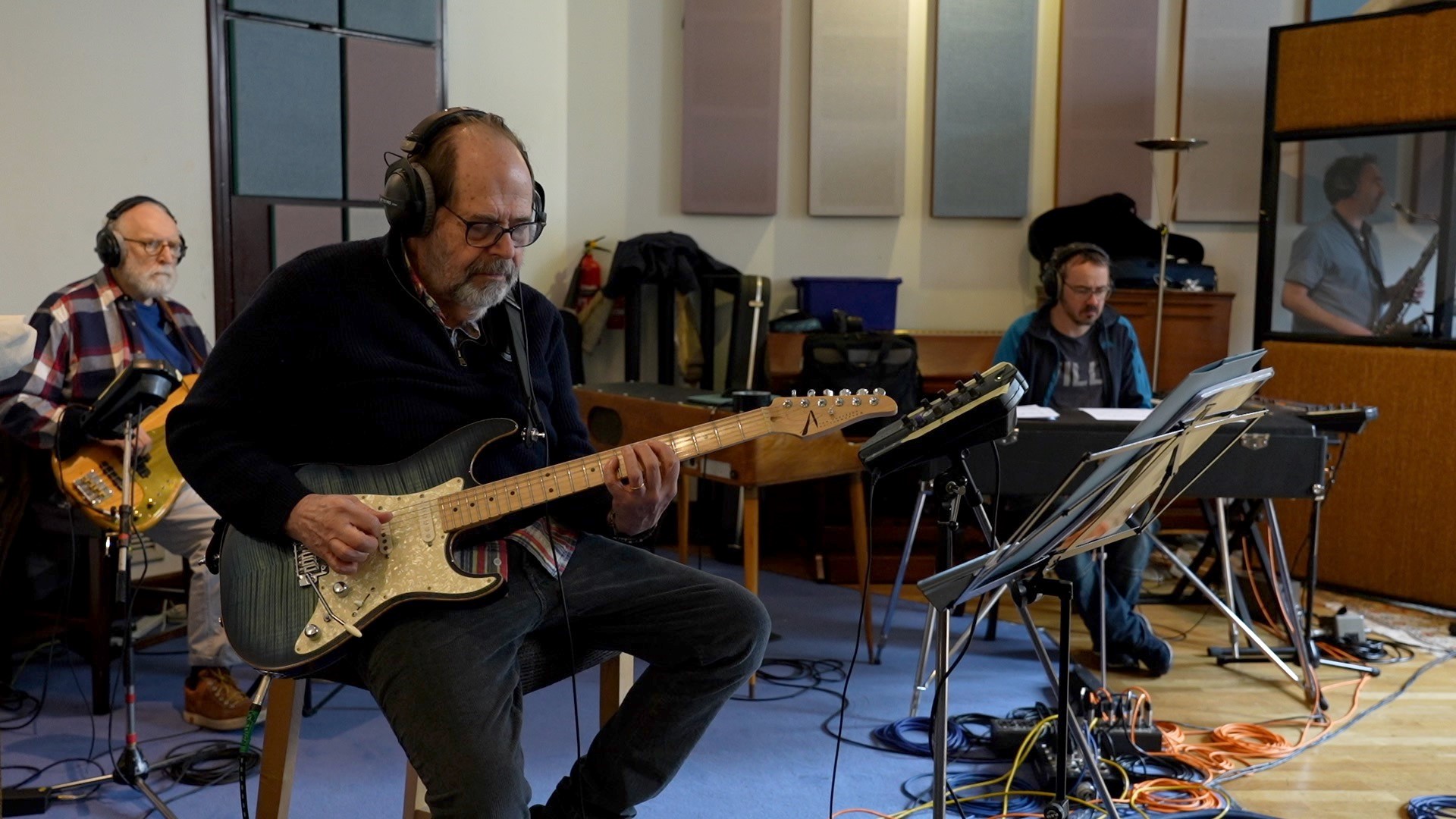
Left to right – session musicians Mo Foster, Ray Russell, Jim Watson and Simon Willescroft © Sav Kyriacou
The latest Digital Works project we have supported – “On the Record” - deals with a very different aspect of life - the hidden stories of London’s session musicians. As with “Tracking the Heritage” the full set of oral history interviews produced will be deposited with us. These draw back the curtain on the hidden world of this industry in London and the many music studios that peppered the city including, within Camden, at Camden Town, Chalk Farm and Primrose Hill.
A documentary film has again been created, entitled “Music Makers”. Drawing on over 20 interviews this explores the working lives of the many musicians who recorded with famous artists, with not so famous artists, for TV, for film, for advertisement jingles.
The film will be screened in Camden Local Studies and Archives Centre at 6pm on the 19th of September, again followed by a q and a’s session. But you can watch it now online here
Archives of Artist and Printmaker, Richard Beer
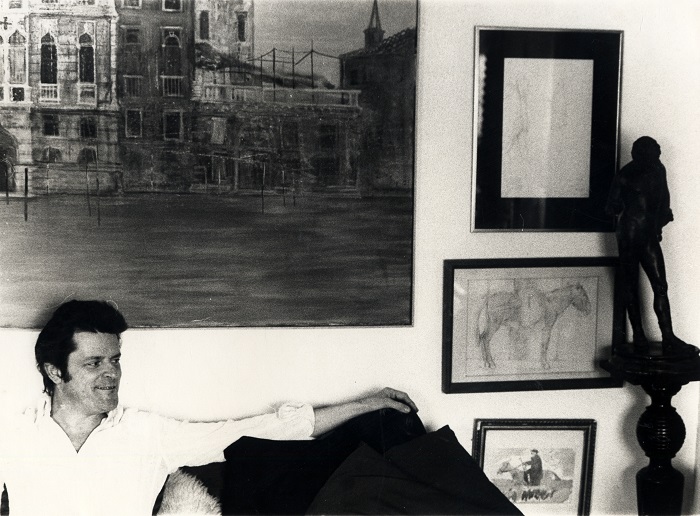
Richard Beer at home around 1970 © Camden Local Studies and Archives Centre
We have recently completed cataloguing of an exciting new accession relating to the painter and printmaker Richard Beer who was a long-term resident of Primrose Hill. Jennifer Hawkins Opie, author of “Richard Beer: Art and Life” (published in 2019) has kindly deposited with us her collection relating to the artist whose work can be found in Tate Britain, the V & A and galleries and museums abroad. He was also a book illustrator, a designer for ballet and theatre, and a teacher at Regent Street Polytechnic and Chelsea School of Art.
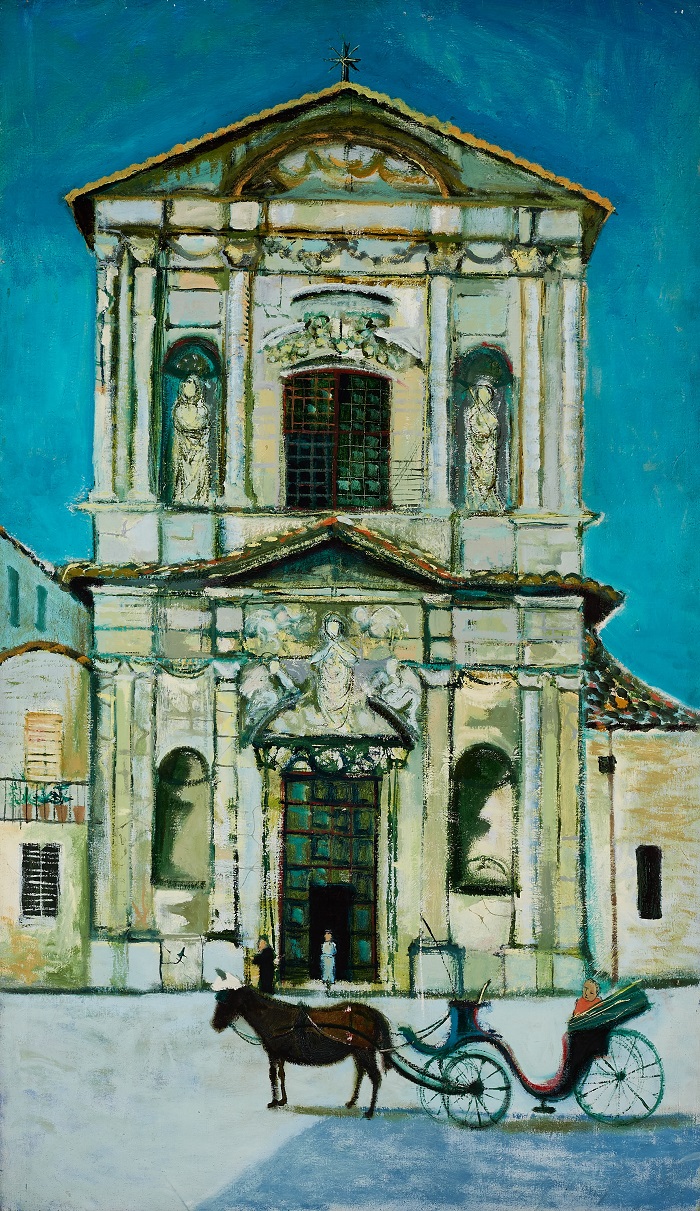
“Casale” by Richard Beer 1956 © Michael Fletcher
Beer lived at 21 St Mark’s Crescent for over fifty years up until his death in 2017, aged 88. He was also educated within what is now Camden – studying at the Slade School of Art in the later 40s. And his retrospective was held in Bloomsbury, at the Abbott and Holder gallery in Museum Street.
Ms Opie’s collection embraces exhibition catalogues, photographs, travel diaries (with sketches) and correspondence, including letters from the poet, John Betjeman.
The catalogue of the collection can be viewed here
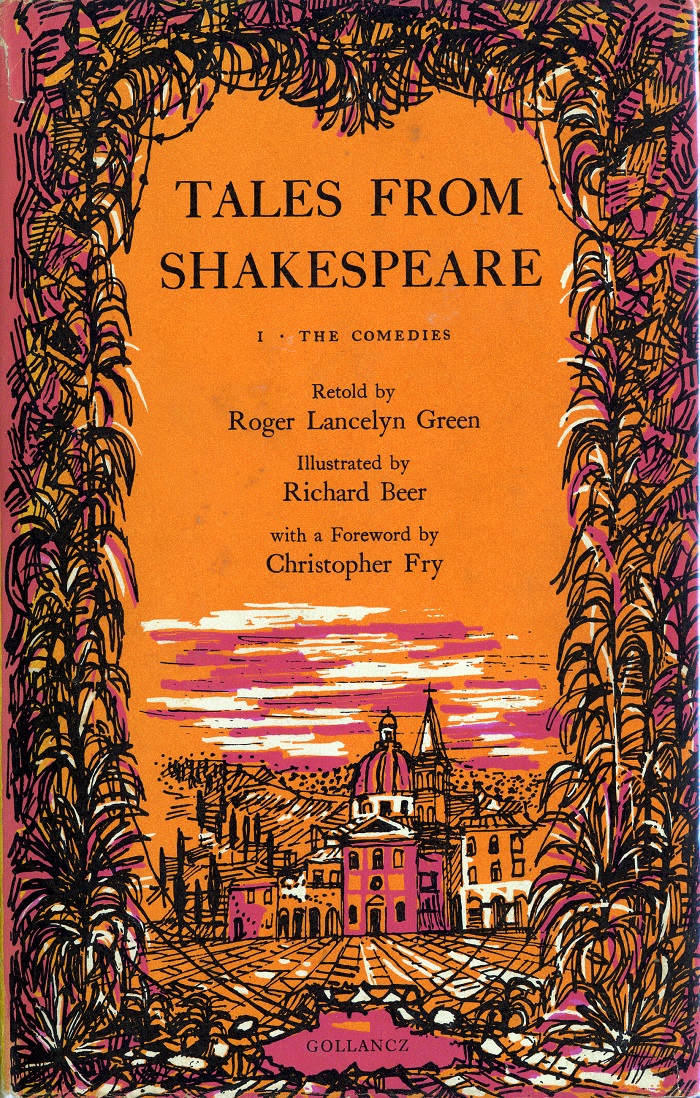
1964 publication illustrated by Richard Beer
Celebrating the Bard of Bengal
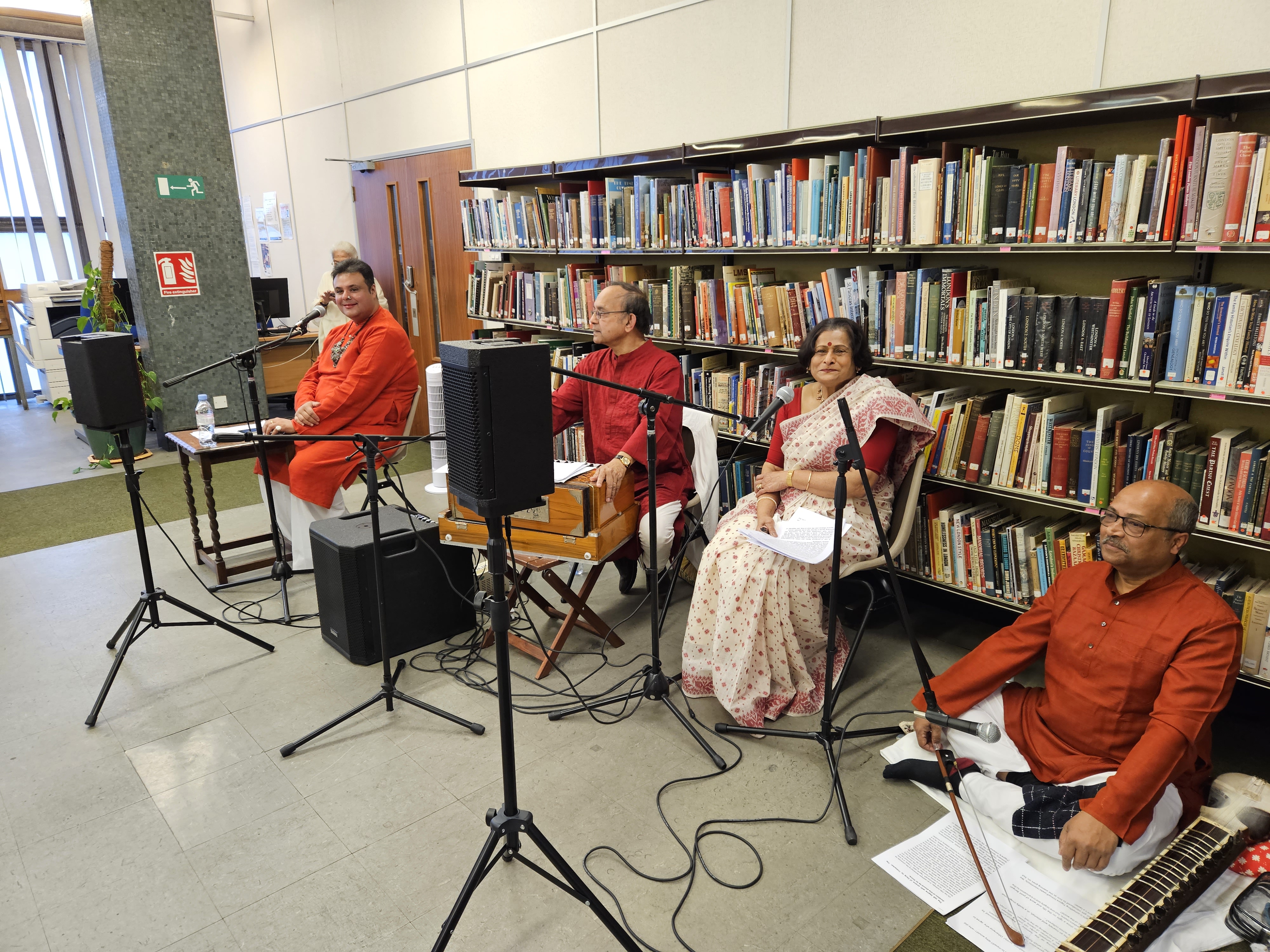
The performers © Sanjay Dasgupta
On the 30th of May we were delighted to hold a very special event in Camden Local
Studies and Archives Centre. The Tagore Centre UK presented an evening
celebrating the Bengali literary giant, Rabindranath Tagore, the “Bard of Bengal”.
Poet, dramatist, novelist, composer, singer, philosopher and educationalist, Tagore
became in 1913 the first non-European recipient of the Nobel Prize for Literature. In
1912 he was resident within what is now Camden in a house which still stands – 2
The Villas in the Vale of Health.
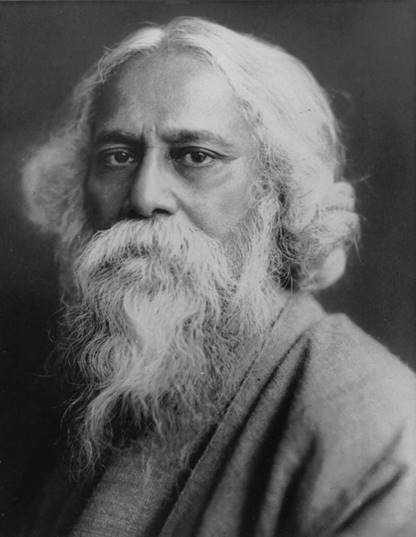
Rabindranath Tagore
Talking us through the great man’s life and work was – all the way from Kolkata in
India – the celebrated interdisciplinary artist and screen personality, Sujoy Prosad
Chatterjee. Sujoy gave some wonderful performances of Tagore’s poems and
dramatic works. His passion for the writer was manifest.
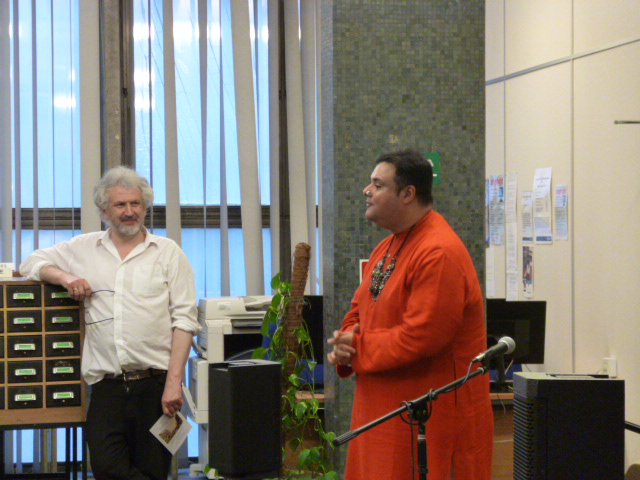
Sujoy Prosad Chatterjee
Mamata Lahiri, a noted Rabindrasangeet exponent, sang beautifully, ably
accompanied by Dr Tirthankar Roy, a legendary ersaj player and Sunith Lahiri on the
harmonium.
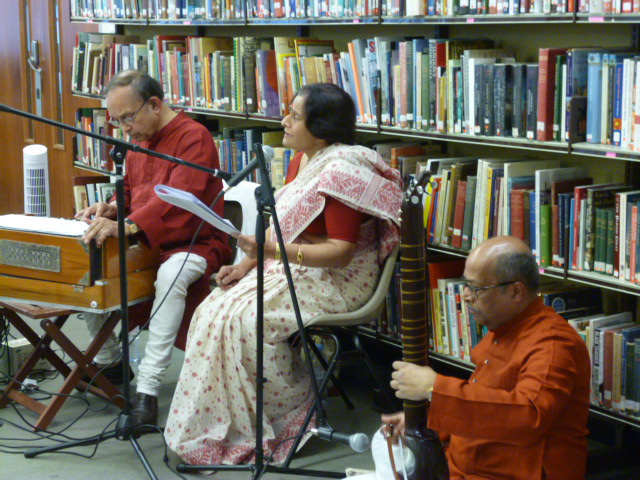
Sunith Lahiri, Mamata Lahiri and Tirthankar Roy
A huge thank you to Srabantika Dasgupta of the Tagore Centre for making the event
happen. I have my copy of Tagore’s selected works – in translation of course – ready
to start reading. And I look forward to us working with the Tagore Centre again in the
future.
Down at the Old Archives Centre
Camden Local Studies and Archives Centre hosted a memorable event on Thursday 27th April, a celebration of the old Holborn Empire, the music hall which once stood on High Holborn just to the east of today’s underground station. The evening was brought to us by the wonderful Good Companions, a troupe whose mission is to tell the story of London through the songs that Londoners used to sing, the songs of the music hall, once the capital’s most popular form of entertainment. They led us through the history of what was once one of London’s largest and most cherished venues, entertaining local people from the 1850s up until its bombing in 1941 and playing host to the leading stars of Victorian and Edwardian music hall. We were transported back in time through terrific performances of old music hall numbers which would have been performed at the Empire, among them “Champagne Charlie”. “My Old Man”, “The Boy in the Gallery” and “London Pride”. We learnt how the songs told the tales of everyday life for local residents – revelry in the local pubs, poverty in the rookeries, crime, romance, and finally, resilience as Holborn was devastated during the Blitz. Most of all, we learnt how the songs dealt with the hardships of life through a plenitude of humour and fun Thank you once again to the Good Companions for a such a special evening. We hope we can have you back!
Celebrating and Collecting Camden's Black History
On 13 March Camden’s first Black British History hub opened in a former florist’s shop in Malden Road, Kentish Town. Founded by Community Engagement Co-ordinator, Emily Momoh, and supported by London Borough of Camden, it showcases the exhibition Emily curated “We Were Here” which tells the stories of eight key figures in Camden’s black history - Olaudah Equiano, Dido Elizabeth Belle, Robert Wedderburn, Billy Waters, Mary Prince, Sarah Parker Remond, Beryl Gilroy and Jerry Williams. The hub also contains a mini-library on aspects of Black history. From June it will be running workshop activities, events and exhibitions to celebrate the 75th anniversary of Windrush. The hub is based at 18 Malden Road, London NW5 3HN. open from Tuesday to Friday from 11am to 4.30pm. Admission is free.
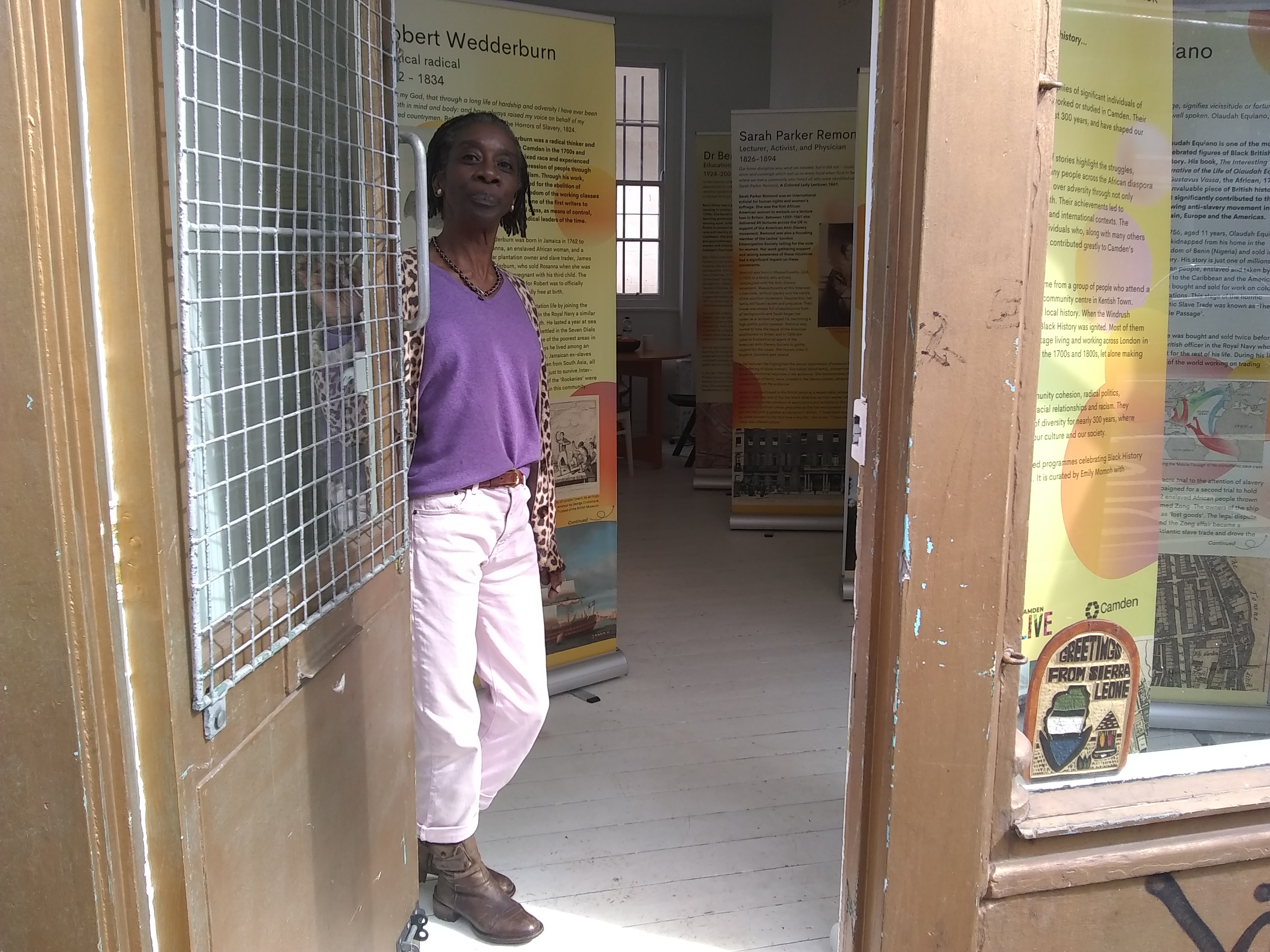
Emily Momoh at the Camden Black British History Hub in Malden Road
As part of Camden’s Strategy for Diversity in the Public Realm, Emily will be leading “Hidden Voices” a project to collect historical information, documentation and artefacts of Camden’s African and Caribbean communities of the Windrush era and pre-Windrush – from the 18th century on. The material collected as part of the project will be added to our collections here at Camden Local Studies and Archives Centre. If you are interested in volunteering to assist in the project Emily would be pleased to hear from you at: [email protected]
Camden's Historians of the Future
Approaching ten years ago Camden Local Studies and Archives Centre began offering class visits to Camden primary schools in which teachers could bring in their pupils to work with local history resources relating to historical subjects they were studying. Over the years we built up the service until we were running, on average, one class visit per month. Then Covid hit and of course this aspect of our service became impossible for a period. I am pleased to say, however, that as life has returned to normality in recent times, we have been able to revive this offer to schools. Currently we are in the middle of a period where we have five separate class visits over five consecutive weeks. Recently Eleanor Palmer School in Kentish Town brought in a class and have kindly given us consent to reproduce here some of the photographs they took of the session.
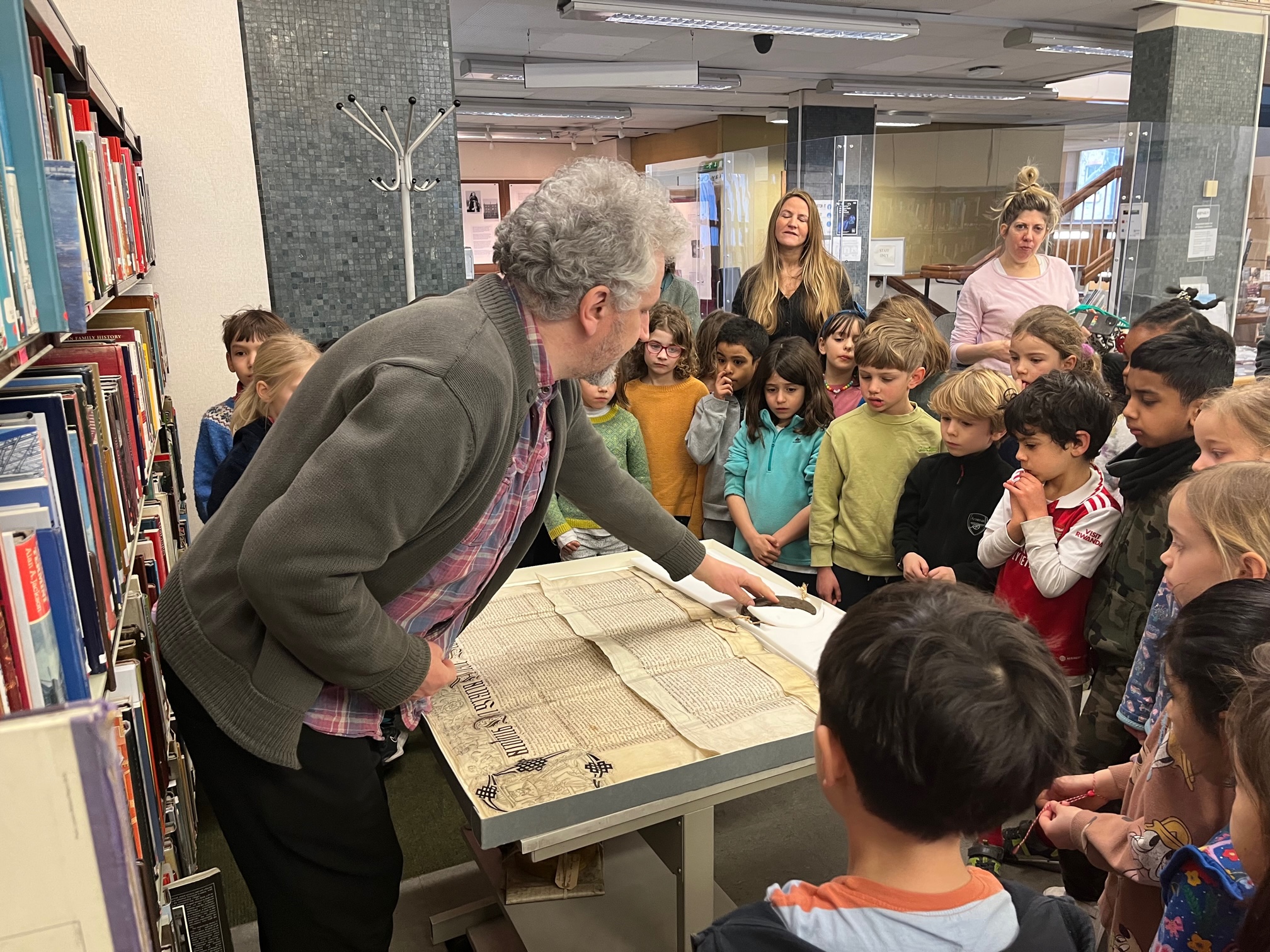
© Eleanor Palmer School
My colleagues, Kate and Ingrid, have done brilliant work in publicising our offer to schools, arranging visits and preparing all the resources for the sessions. The schools which visit let us know in advance what area of history they are studying and Ingrid and Kate prepare a range of related resources for them to work with including books, photographs, maps, newspapers and illustrations. We mainly use facsimiles to prevent any damage by over-boisterous handling!
We run the sessions on Fridays when we are closed to the general public. We rearrange our search room to create four large table areas. Each of the four tables is devoted to materials relating to one particular aspect of the area of study and has a list of questions for the pupils to consider.
I give a short introduction to the session in which I show them one of our prize documents – a letters patent dating from around 1610 issued by King James I. I present it in its large flat box which is about three by three feet in dimensions and ask them what they think is inside. On one occasion one boy suggested “A pizza!” If only…
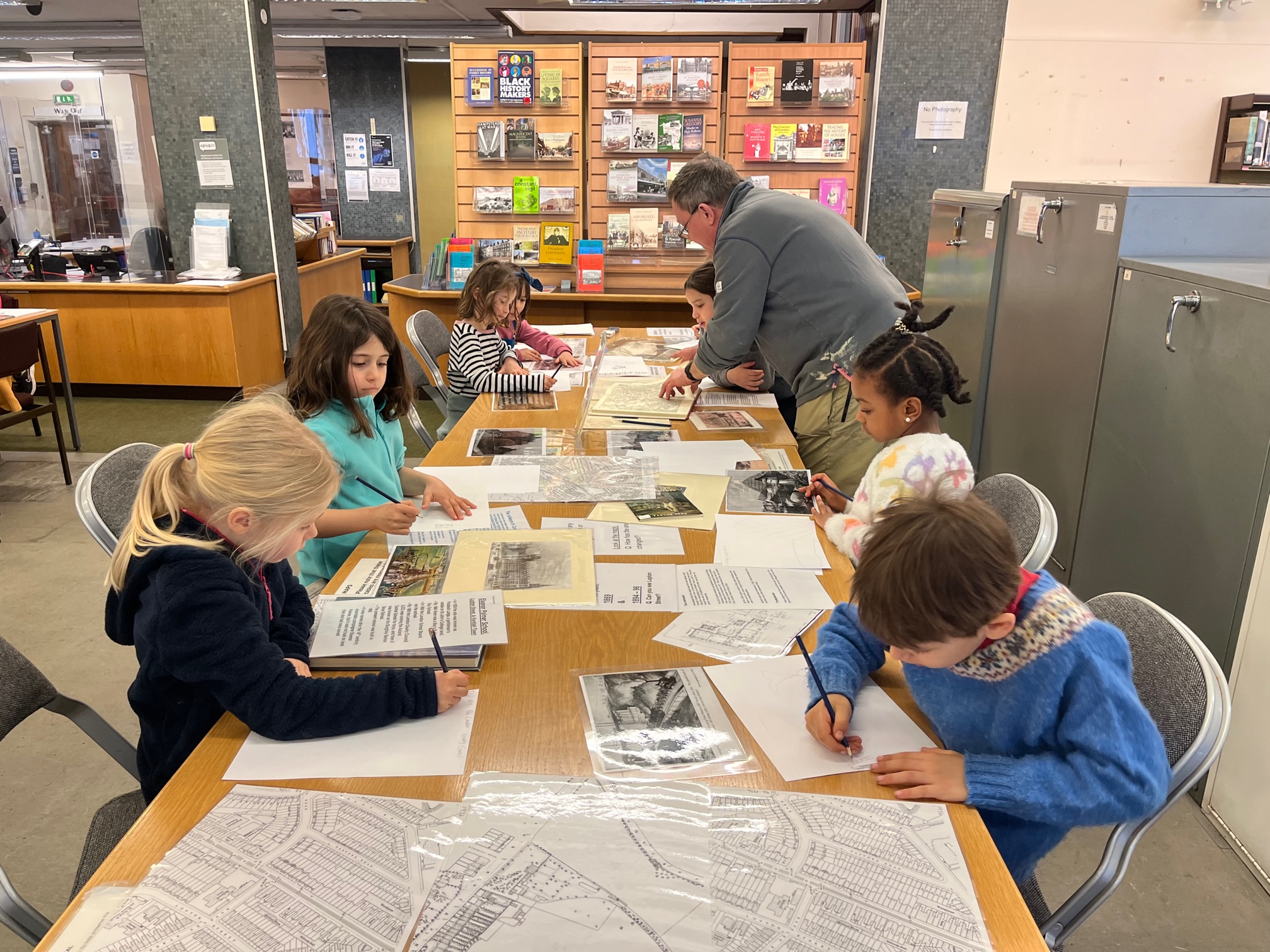
© Eleanor Palmer School
The pupils then start to work with the materials. The class is split in to four groups and each group has fifteen minutes on each table. I ring a bell when it is time to move tables. It is a pleasure to see how engaged most of the young people are during the visits and we have had some excellent feedback from schools. When schools wish to return we consider that proof they have found the sessions beneficial. The children get a particular thrill out of using the magnifying glasses and it has been known for the occasional dispute to arise over whose turn it is to use one.
We have a display on in the Centre currently showcasing some of our children’s books collections – including precious first editions of the famous illustrator Kate Greenaway and the well-known writer, Eleanor Farjeon, both of whom lived locally. The exhibition is entitled “A Selection Box of Children’s Books” and for fun we added in the display cases – well away from the books I might add – some Quality Street chocolates. These have also attracted the notice of our young visitors!
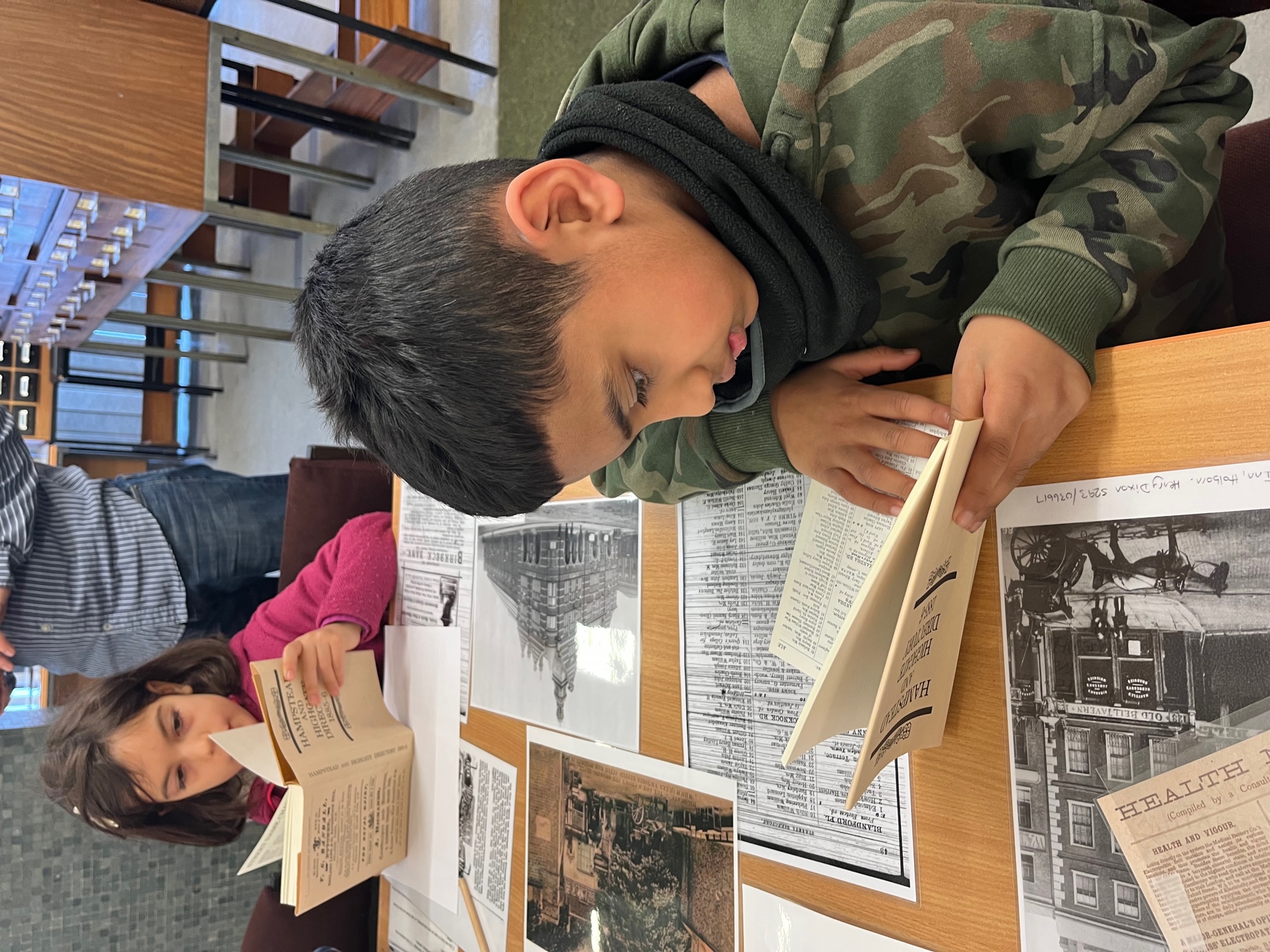
© Eleanor Palmer School
I went to school in the sticks in Cumbria in a small village school which had only about 40 pupils in total. History education comprised watching a half hour tv programme once a week. I am pleased that our Centre is able, through these class visit sessions, to help bring history alive for the children of Camden.
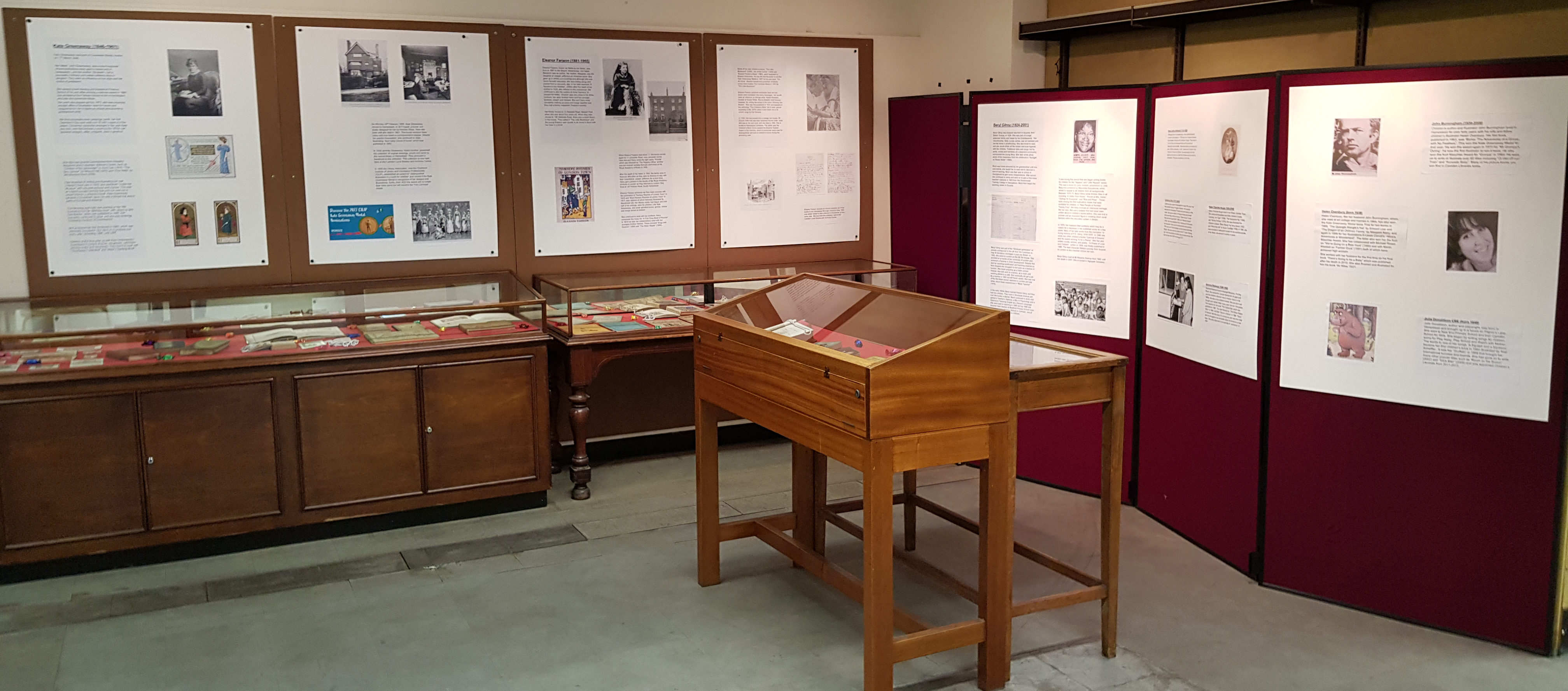
Our exhibition on Camden-based children’s book authors and illustrators
Visitors from Across the Pond
Camden Local Studies and Archives Centre recently played host to a visit from students of New York University. The college has a campus based in Bedford Square in Bloomsbury. The wonderfully enthusiastic, Professor Susanna Horng, brought in 21 of her students of Liberal Studies to find out about our collections and researching in archives and to look at our current exhibition – “We Were Here” – which focuses on eight key figures in Camden’s Black history. Its curator, Emily Momoh, was on hand to answer questions from the students. It was a delight to have the students here and we are hoping that the tours will become a regular annual event.
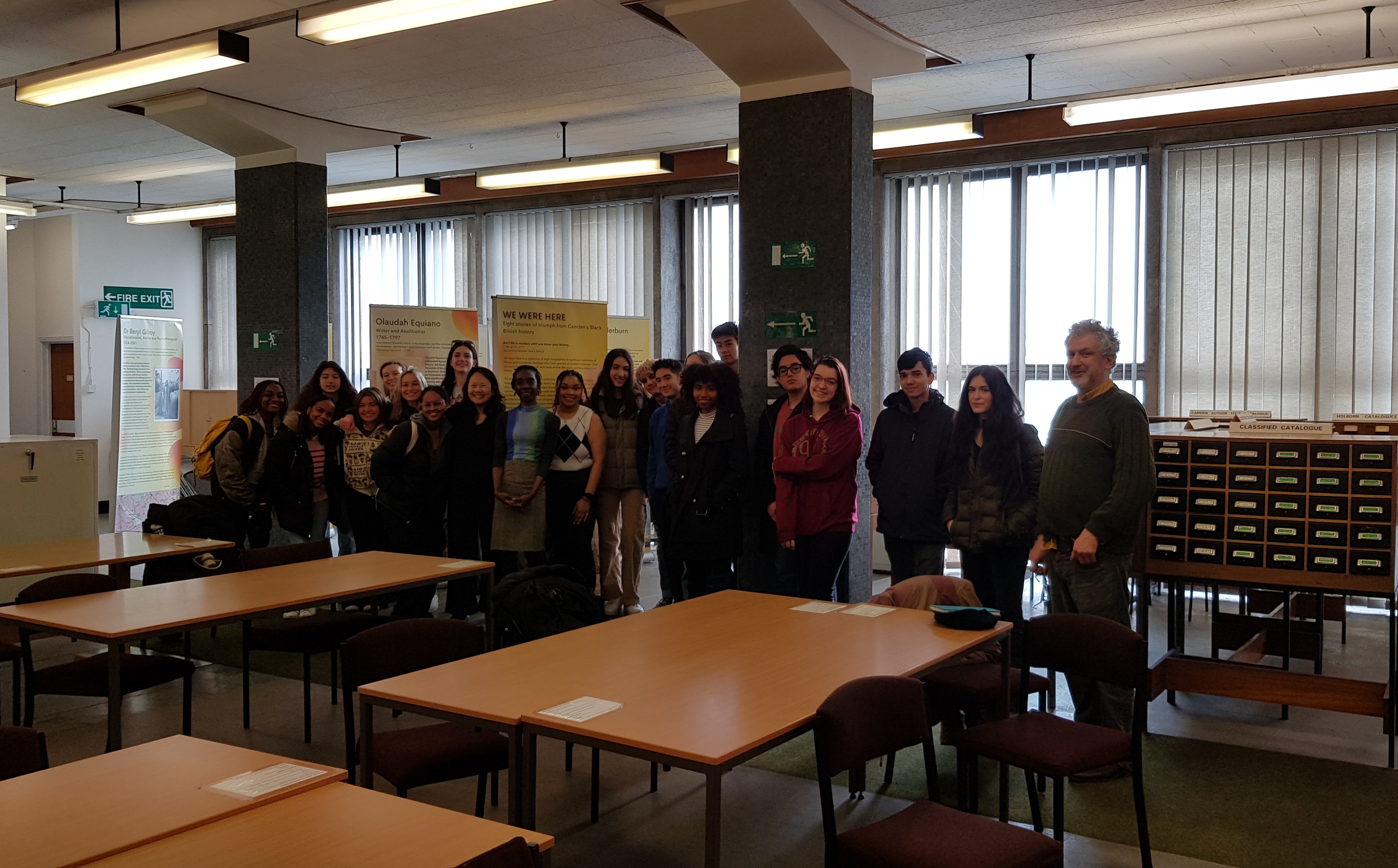
The students on their visit with Professor Susanna Horng (9th from left) Emily Momoh (10th from left) and Tudor Allen, Archivist at the Centre (far right)
(© Camden Local Studies and Archives Centre)
Charles Freestone - A Painter's Family Visits
We recently had an interesting visit to the Centre from a woman called Pauline High and her daughter. After her mother’s death in 2010, Pauline came across an old photograph in an envelope of her grandfather and her mother each holding a painting, the largest depicting the Blitz over St Paul’s Cathedral. The paintings were by her grandfather, a commercial artist who traded under the name of Charles Freestone. The photograph was taken in 1941 by an Evening News photographer when Freestone was on his way to the Royal Academy to enter the paintings either in the Summer Exhibition or the Fireman Artists Exhibition held that year.
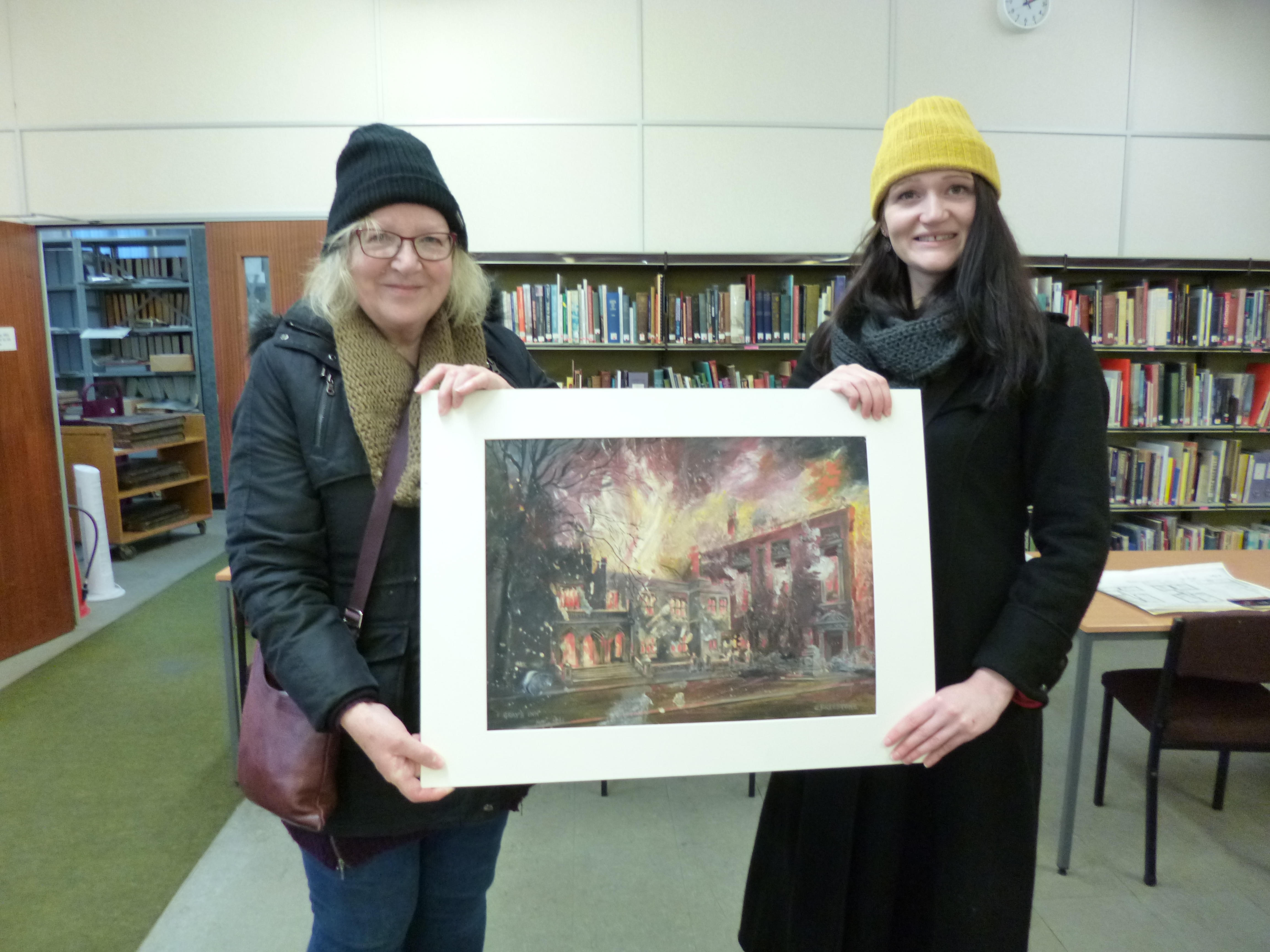
Pauline High and her daughter with Charles Freestone’s painting of Gray’s Inn library on fire after an air raid.
Pauline had recently developed a great interest and love for art history, and had become an amateur artist herself, so upon discovering the photograph she wanted to find out more and see if she could track down the paintings depicted. She contacted the Royal Academy Archives but they held no records about them. However they informed her that several of her grandfather’s paintings were in our collections here at Camden Local Studies and Archives Centre.
We hold six of Freestone’s works – five oil paintings and one watercolour – and we were delighted to show these to Pauline and her daughter on their visit. The artist was an ARP warden in Holborn during the Second World War and the five oils all depict the aftermath of air raids in the Holborn area in the early years of the war including damage to buildings in Theobalds Road – where our Centre is based - and a fire in the library of Gray’s Inn, the Inn of Court located directly opposite to us.
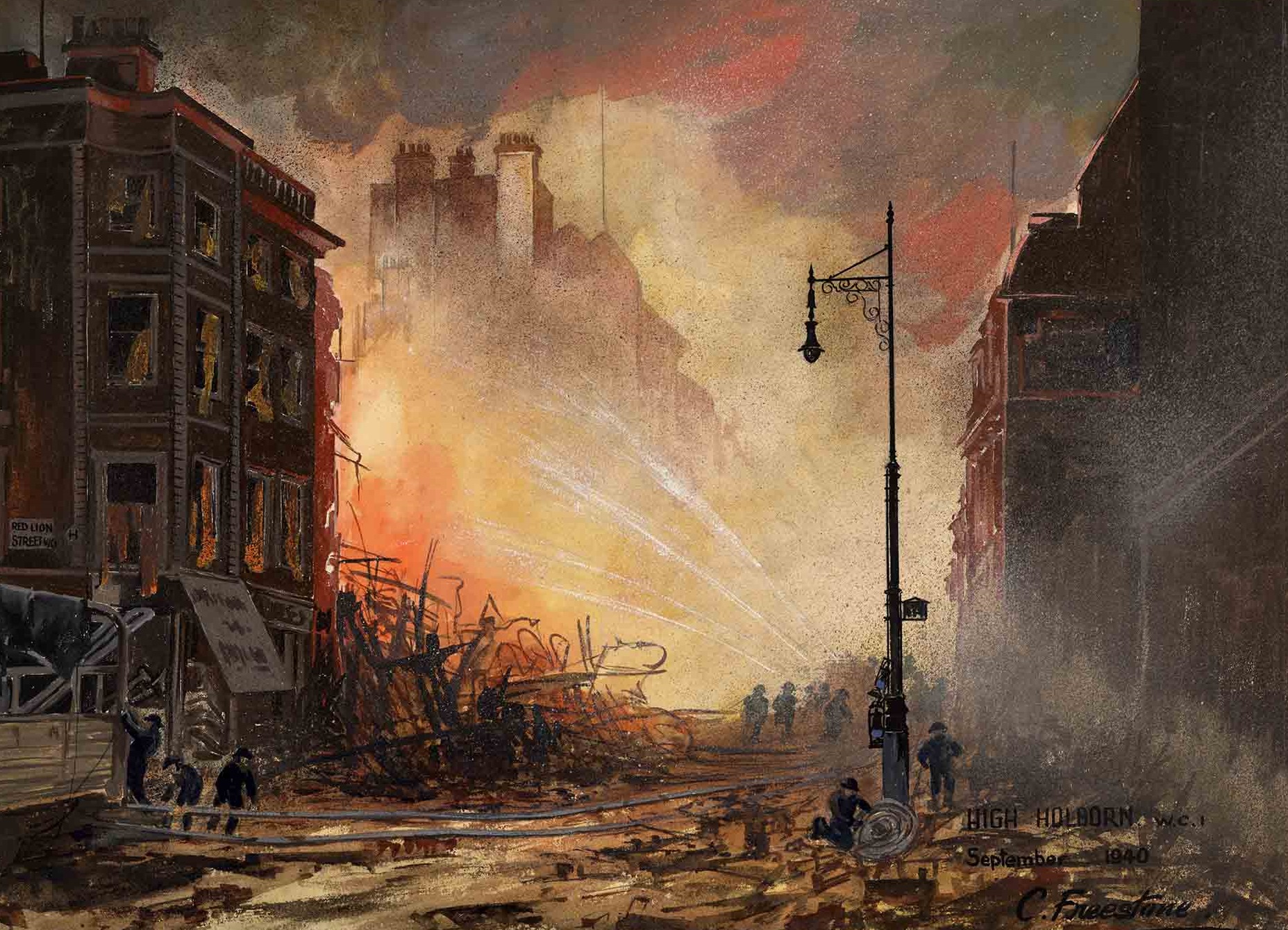
Firemen putting out fire after air raid in High Holborn, 1940 by Charles Freestone © Camden Local Studies and Archives Centre
The watercolour is of St John the Evangelist Church, the beautiful church by John Loughborough Pearson, which once stood in Red Lion Square, where Charles Freestone once lived. The painting captures the church before it was sadly destroyed by wartime bombing.
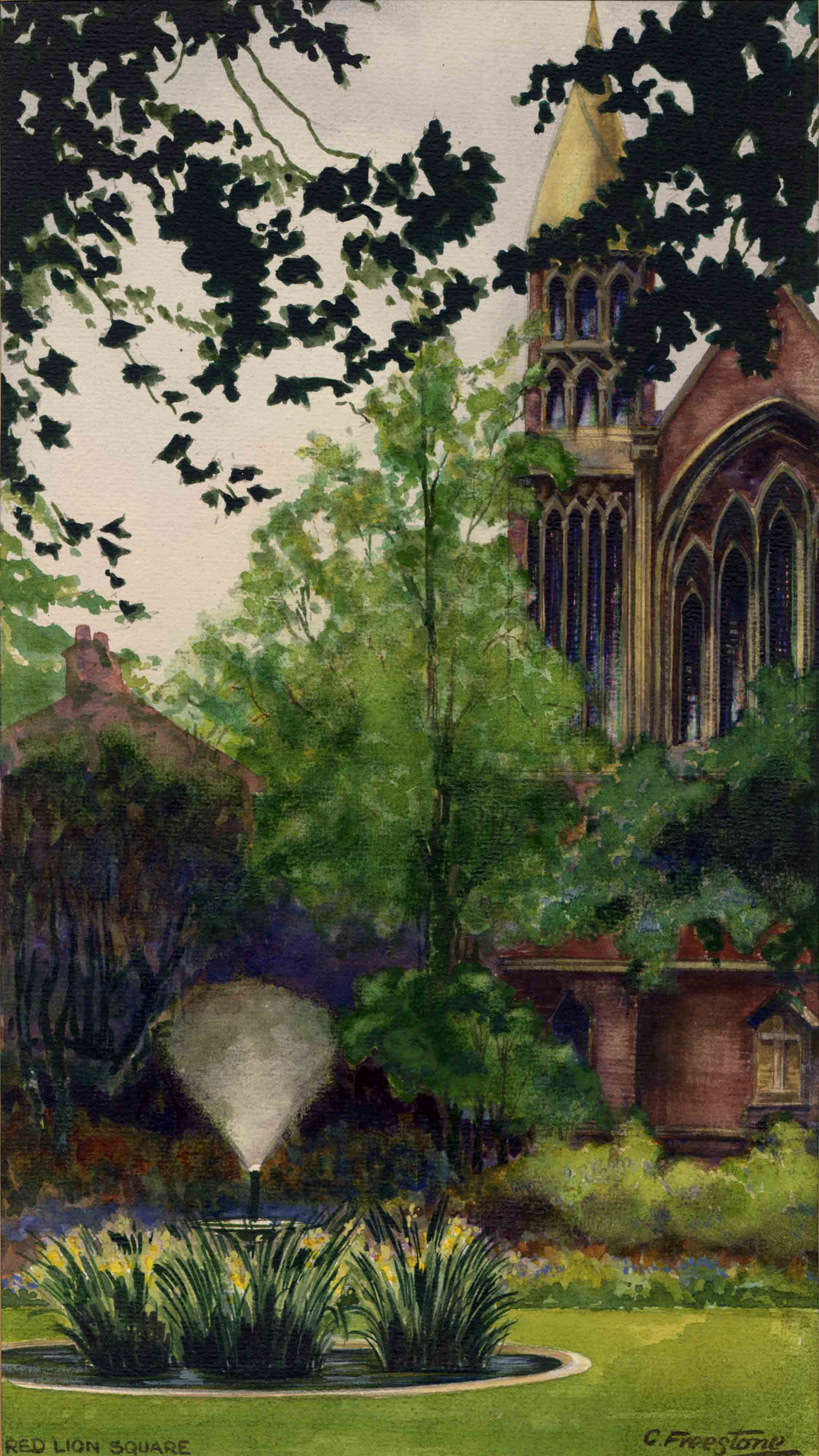
Red Lion Square showing St John the Evangelist church, no date, by Charles Freestone
© Camden Local Studies and Archives Centre
Pauline tell us that to the see the paintings in person was “lovely and overwhelming, quite an emotional experience.”
Unfortunately, the current whereabouts of the St Paul’s painting remains a mystery.
A Samuel Coleridge-Taylor Evening in Camden Local Studies and Archives Centre
As part of Camden’s Black History Season, Camden Local Studies and Archives Centre held a special event on October 11th, an evening celebrating the great composer, Samuel Coleridge-Taylor, who was born in the same street as the Centre is based in – Theobalds Road – in 1875. Hilary Burrage, Founder of the Samuel Coleridge Taylor Foundation introduced an evening of excerpts from his music performed by Foundation members, Richard Gordon-Smith on violin and Martin Anthony Burrage on keyboard with Richard providing a commentary, exploring the composer’s life, work and legacy. The evening included the presentation of a new portrait of Coleridge-Taylor to Camden Local Studies and Archives Centre. Councillor Sabrina Francis, Camden’s Cabinet Member for Young People and Culture, accepted the portrait on our behalf from the artist, Judith Booth. The portrait is currently on display in the Centre during our opening hours.
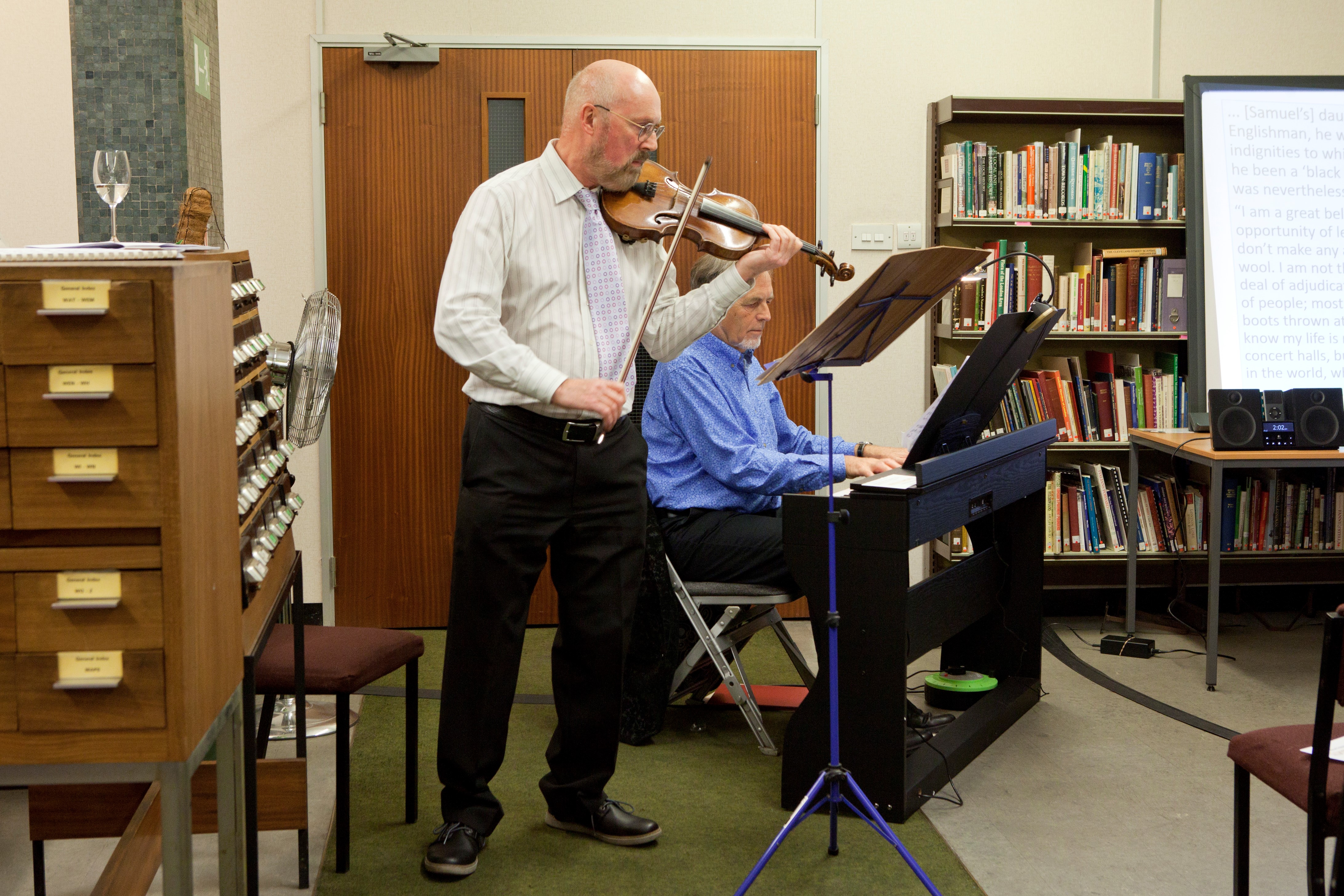
Richard Gordon-Smith (left) and Martin Anthony Burrage (© Hazel Dunlop)
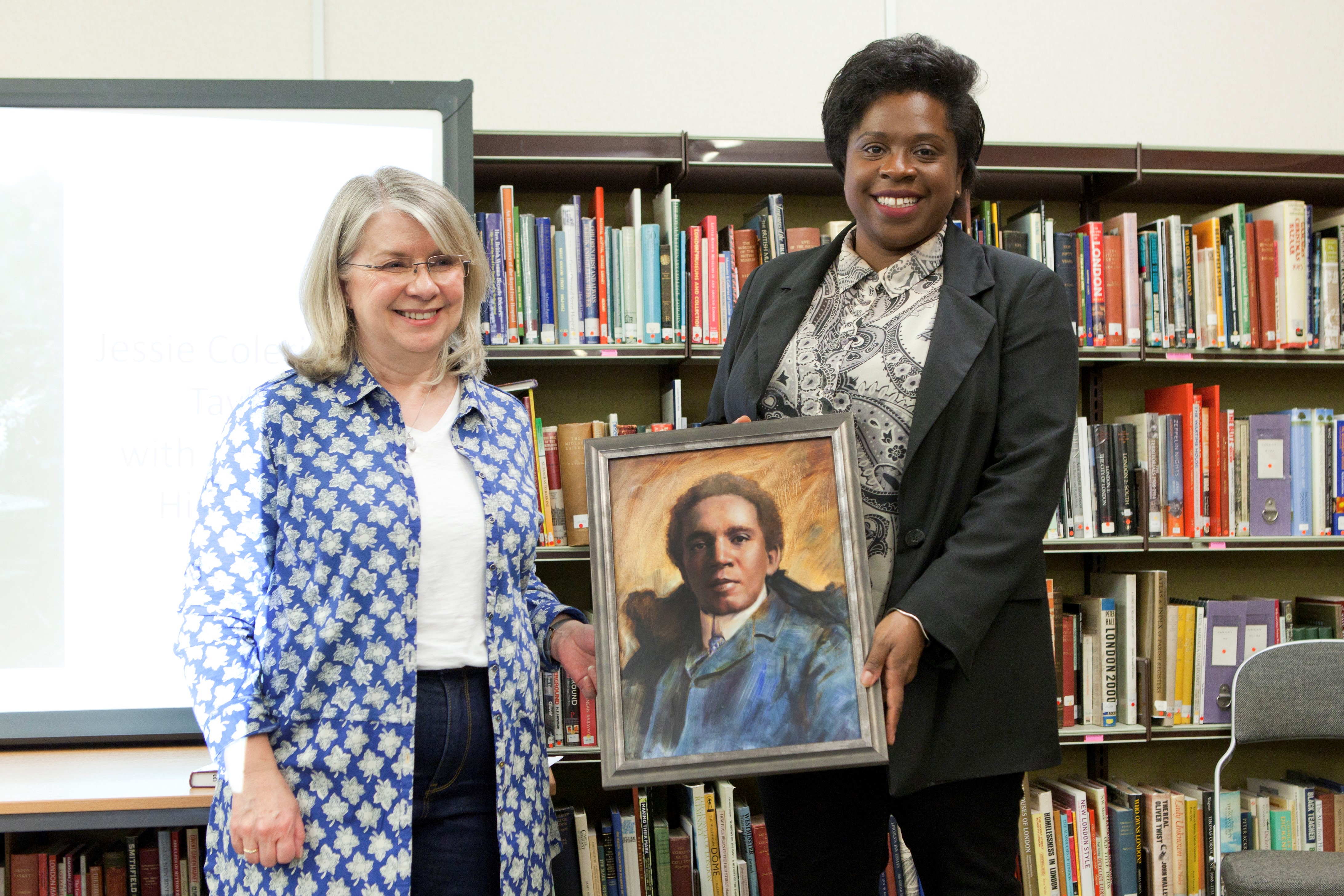
Judith Booth (left) and Councillor Sabrina Francis (© Hazel Dunlop)
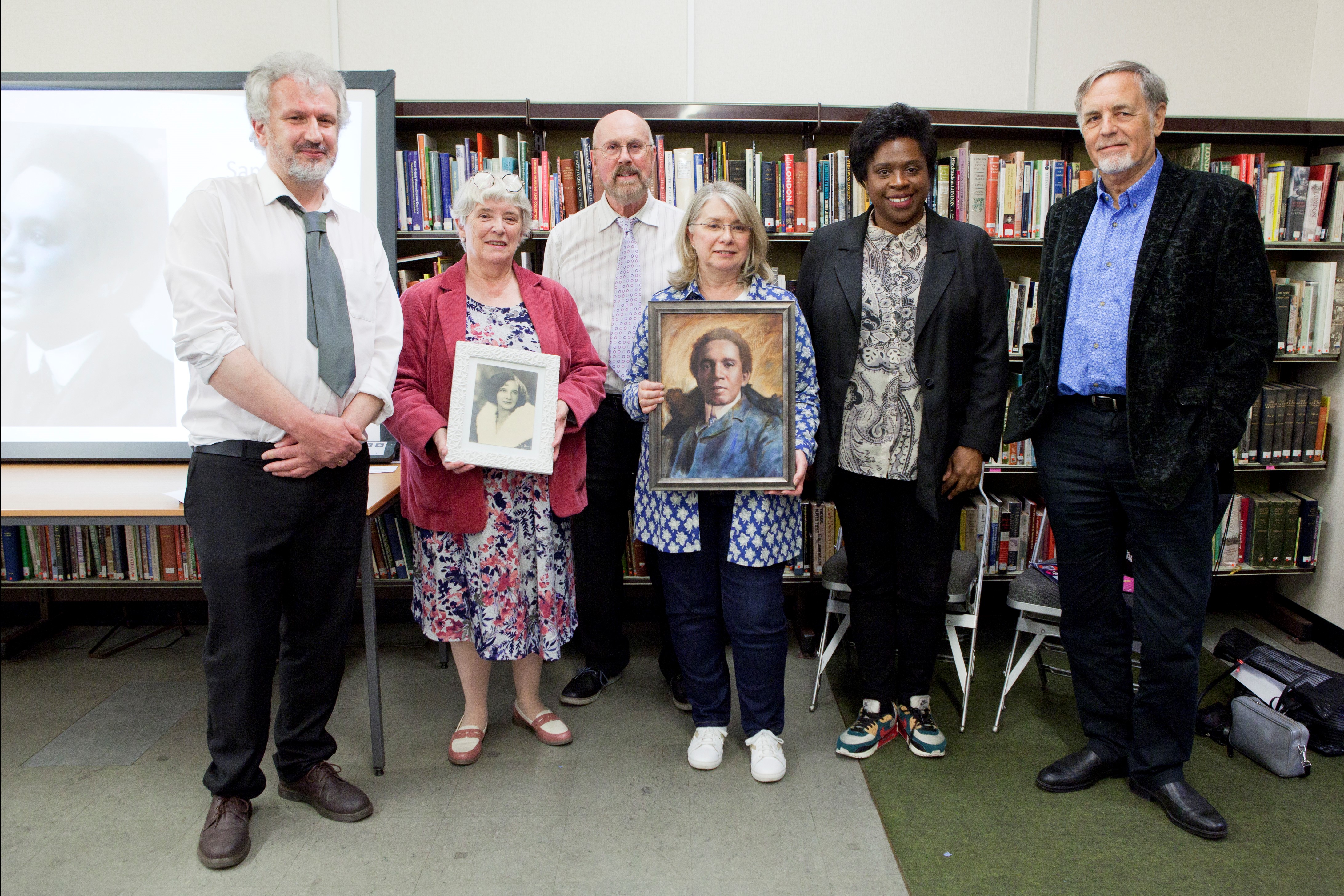
From left to right - Tudor Allen (Archivist at CLSAC), Hilary Burrage, Richard Gordon-Smith, Judith Booth, Councillor Sabrina Francis, Martin Anthony Burrage (© Hazel Dunlop)
